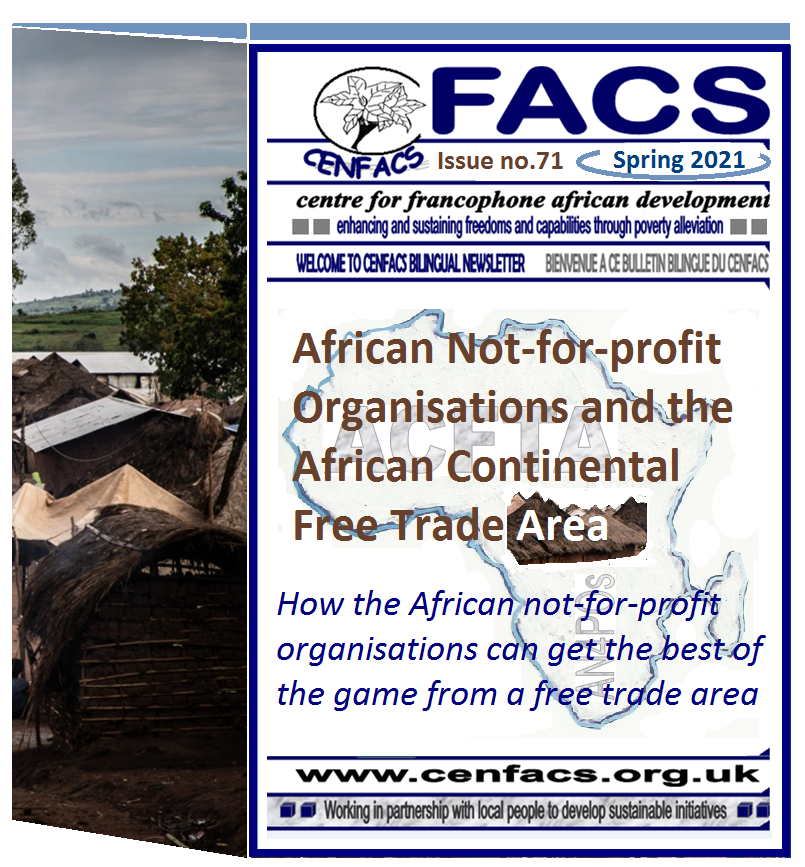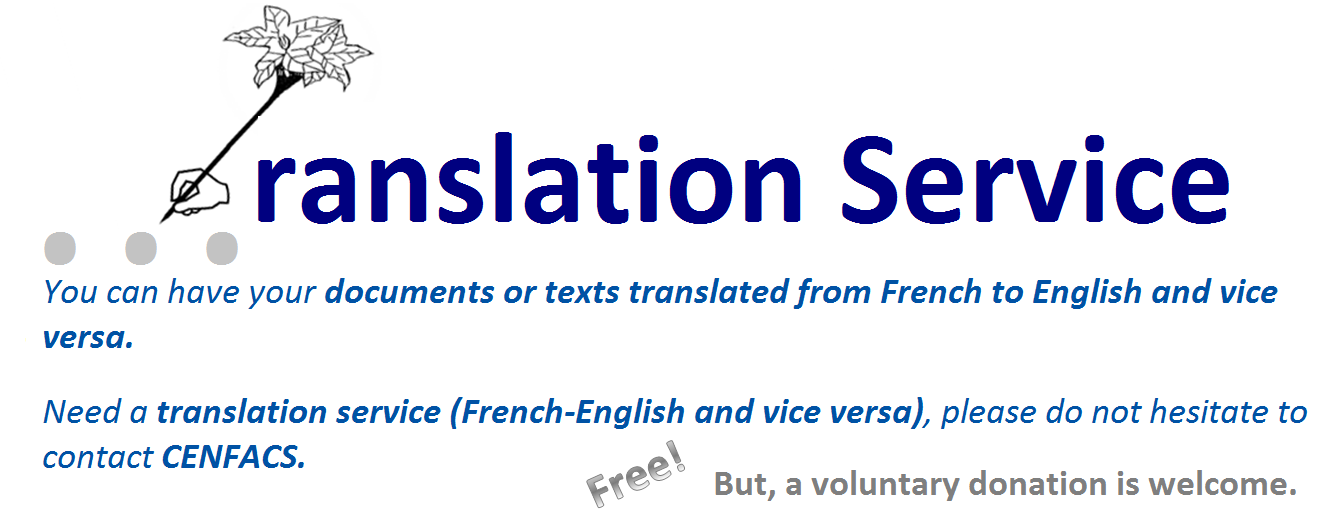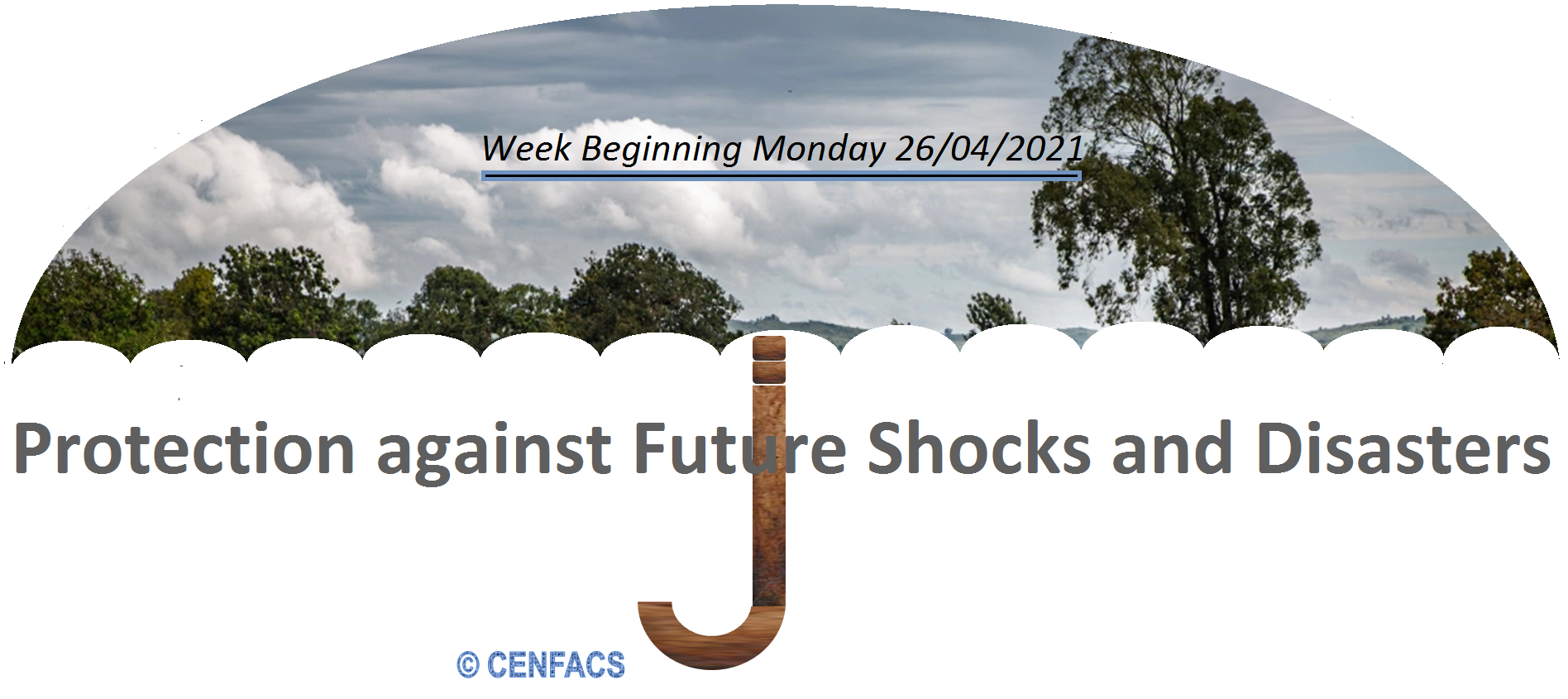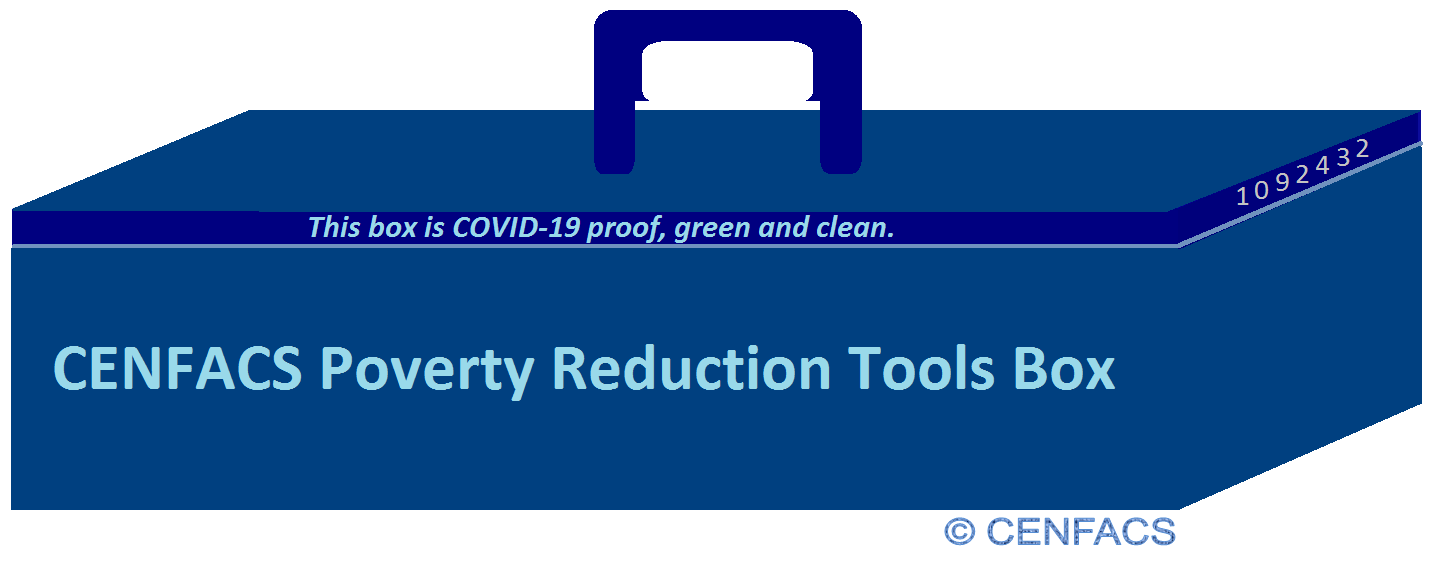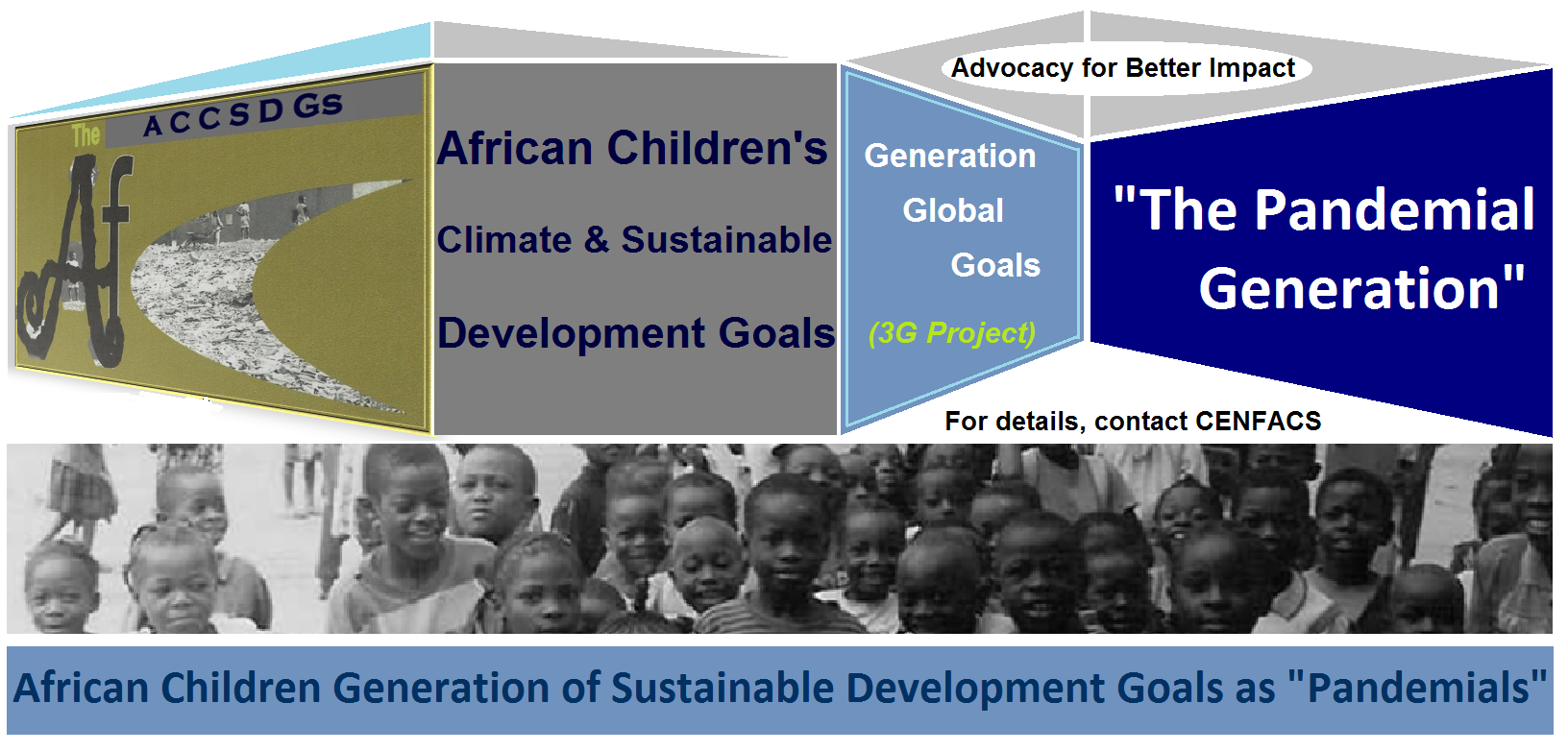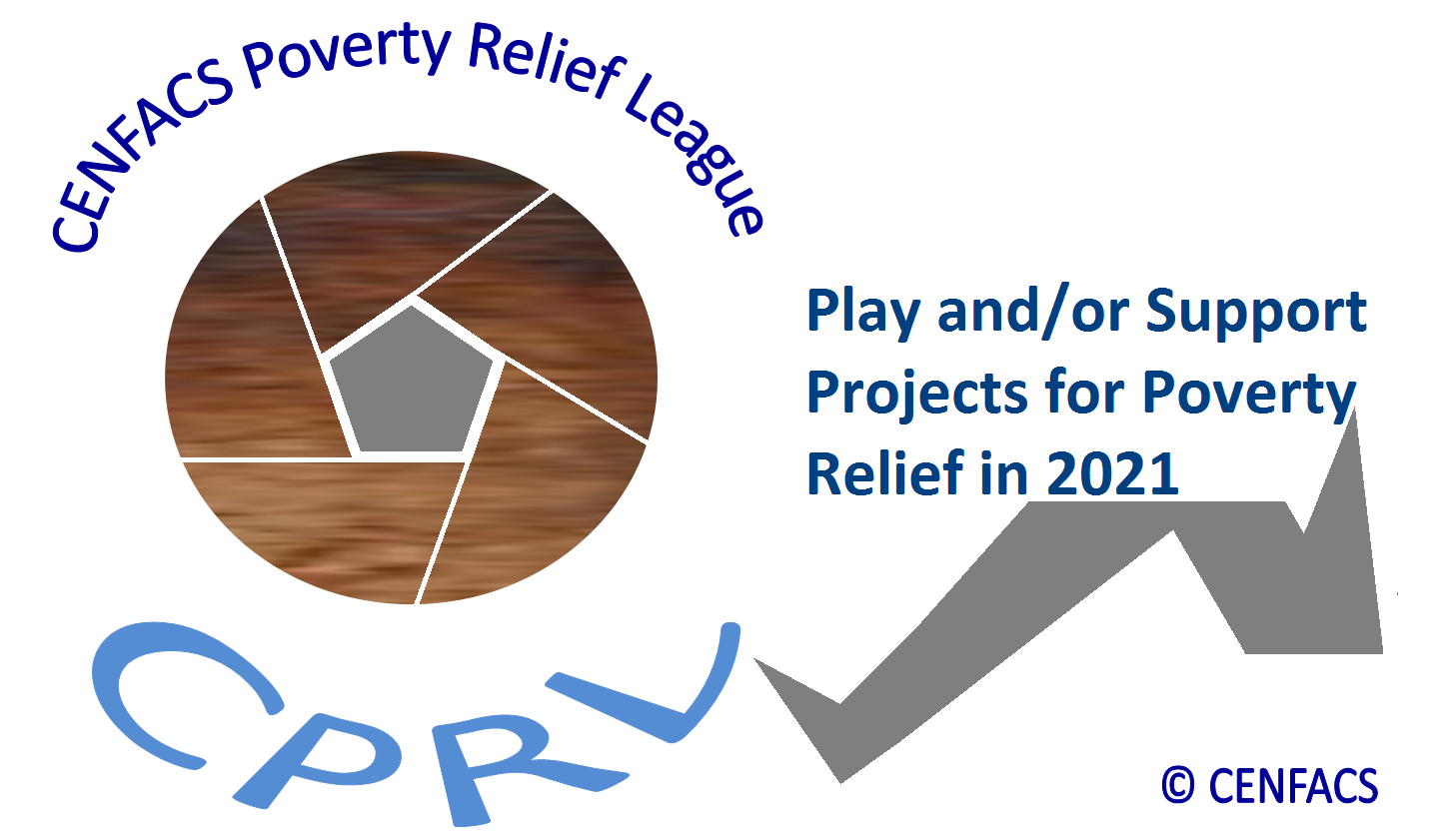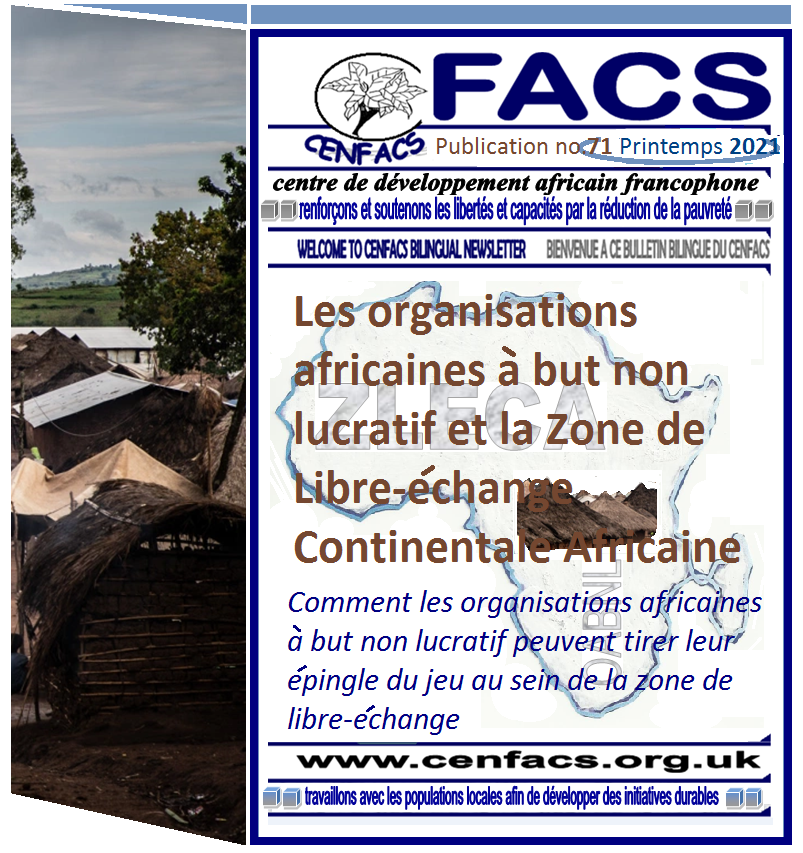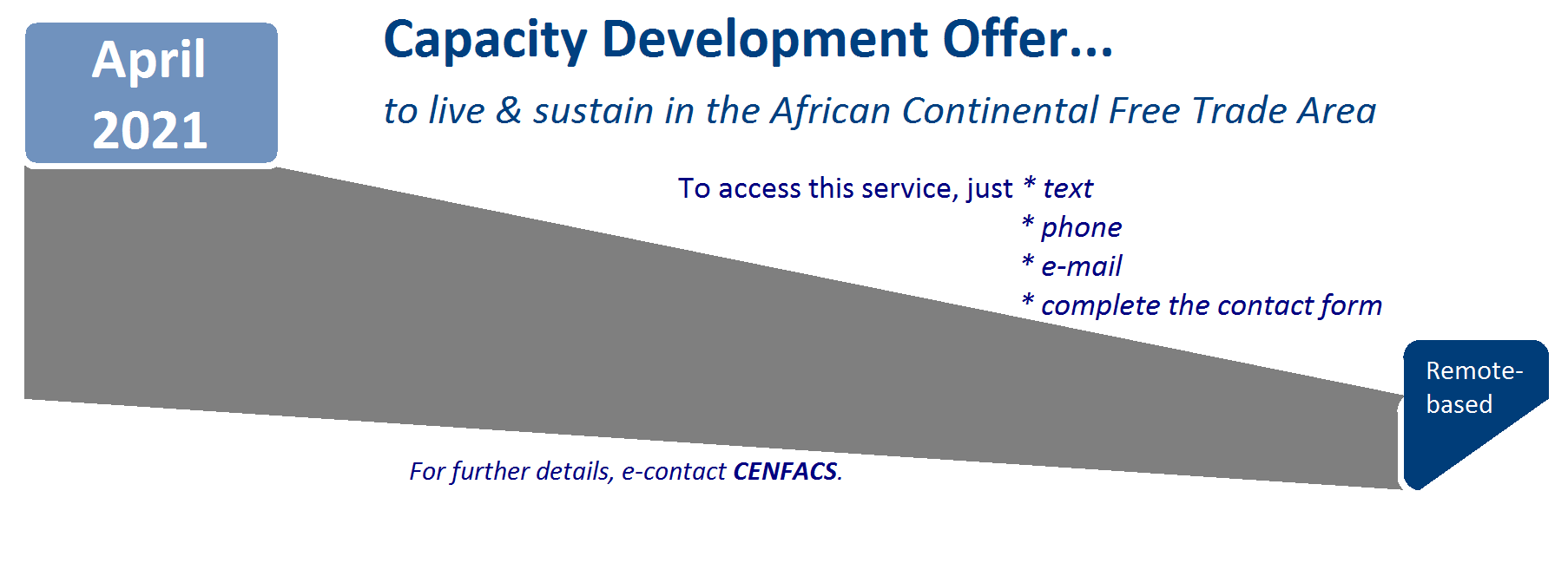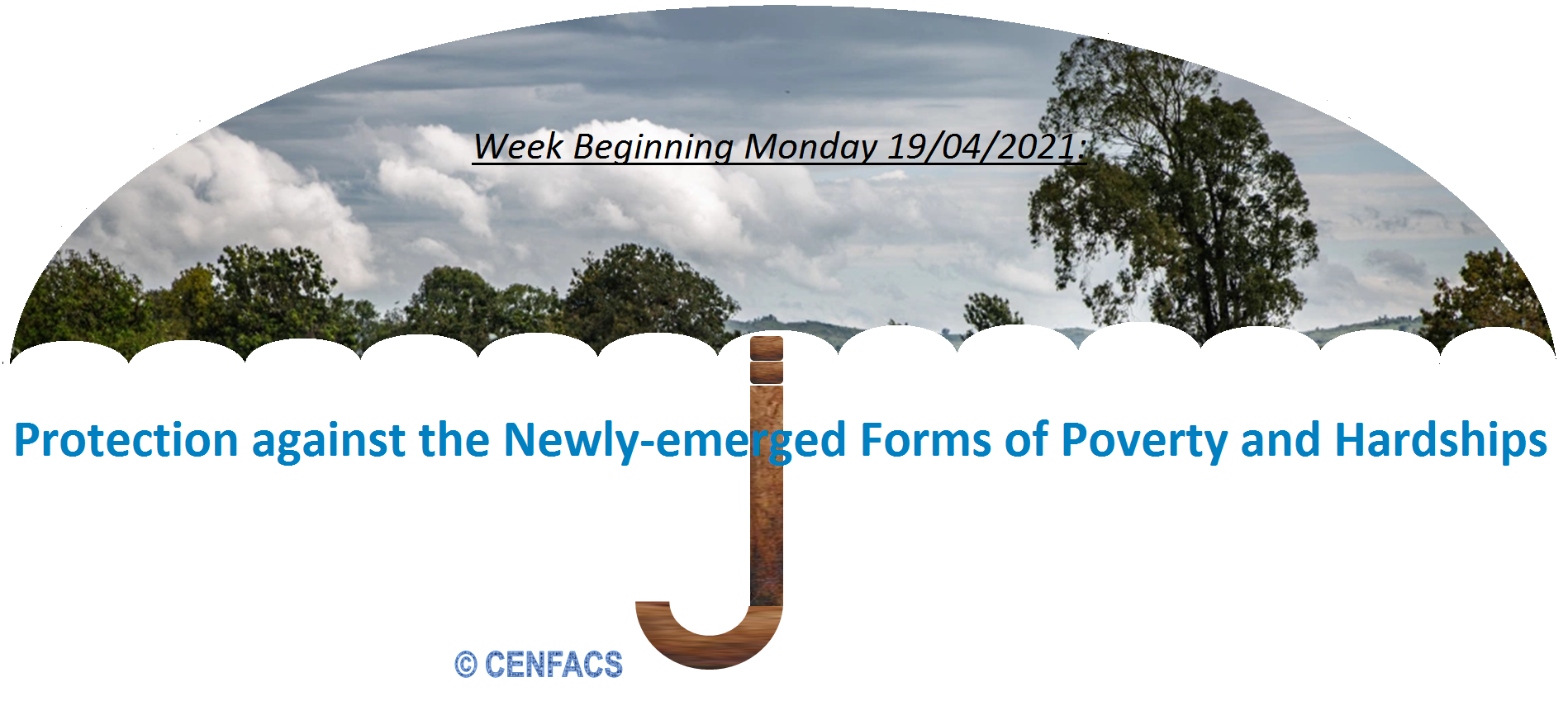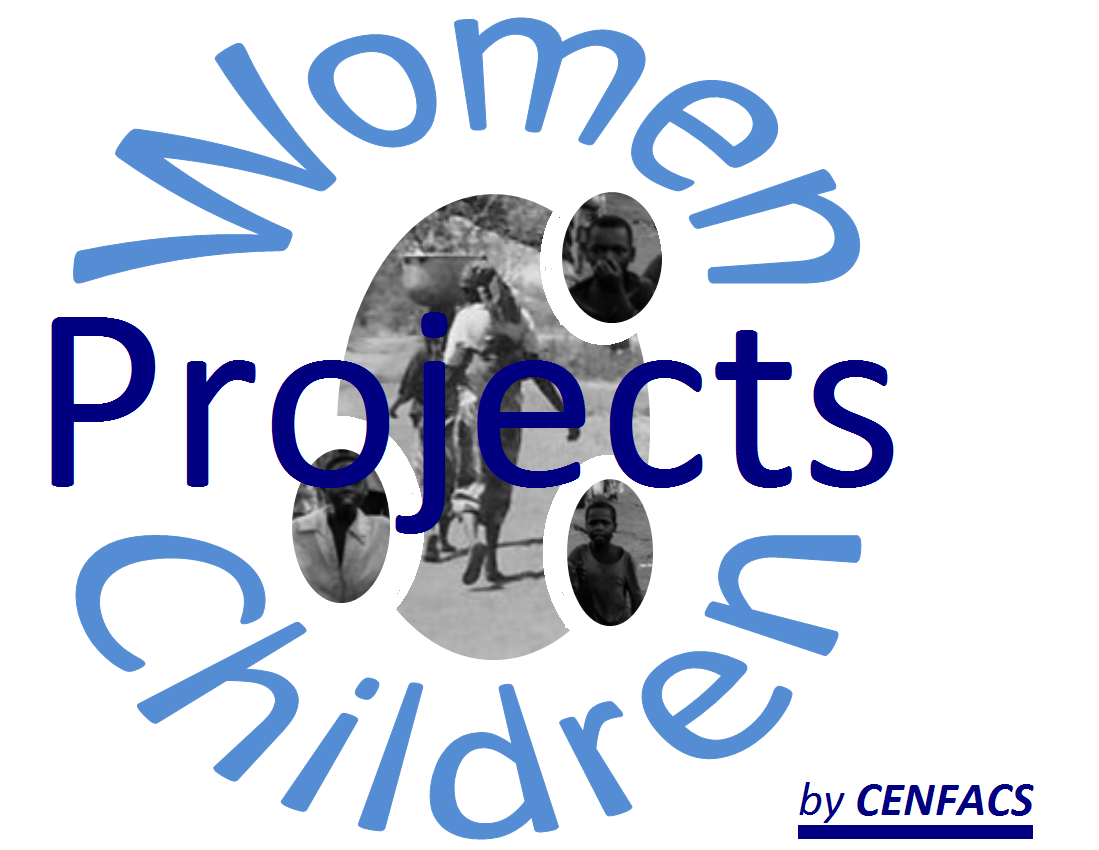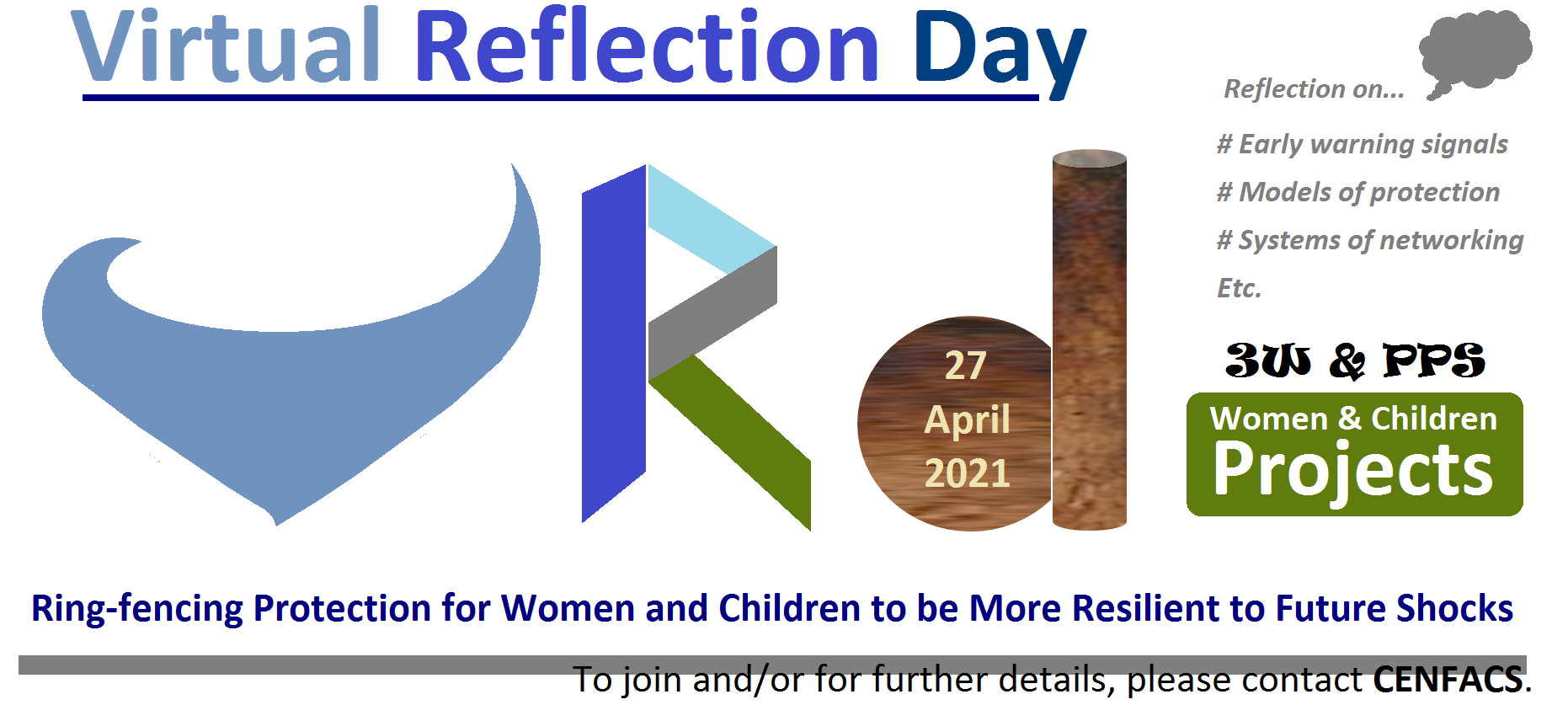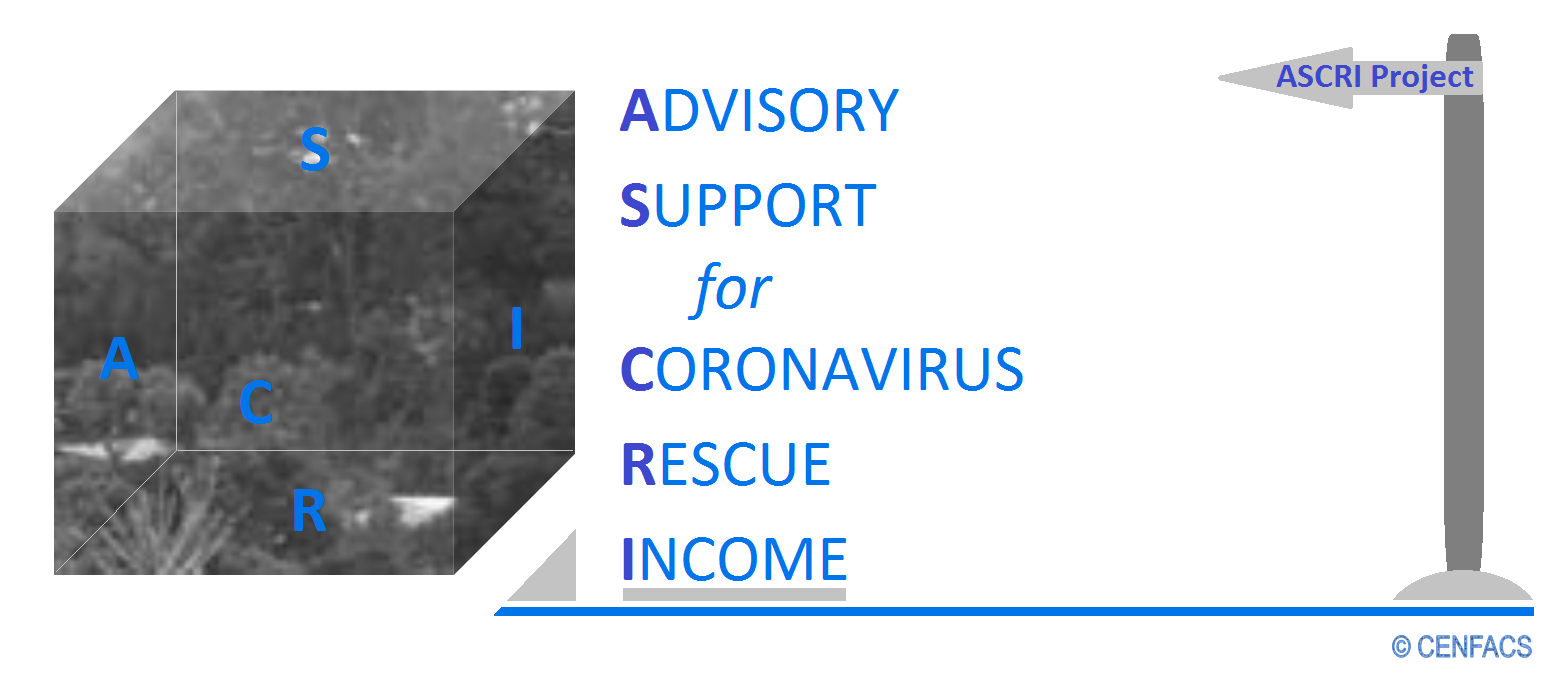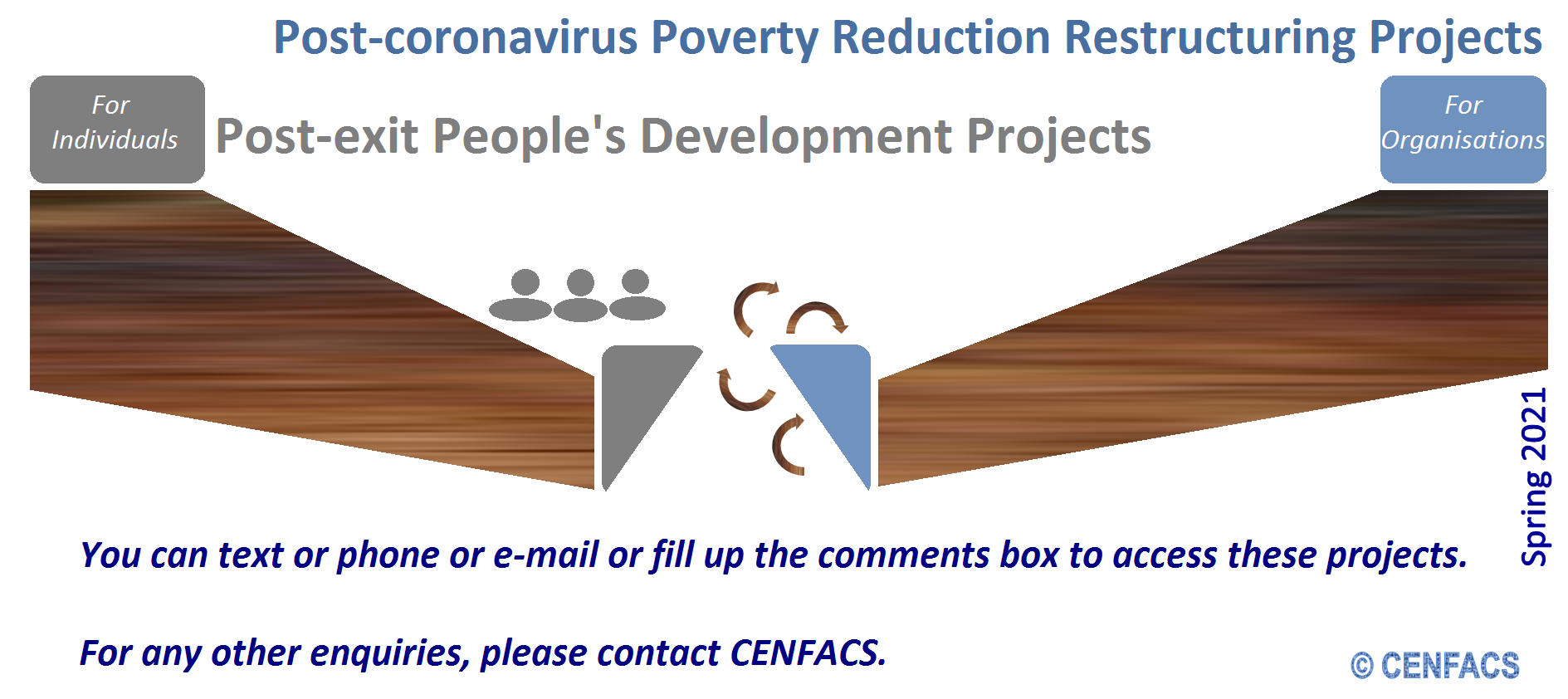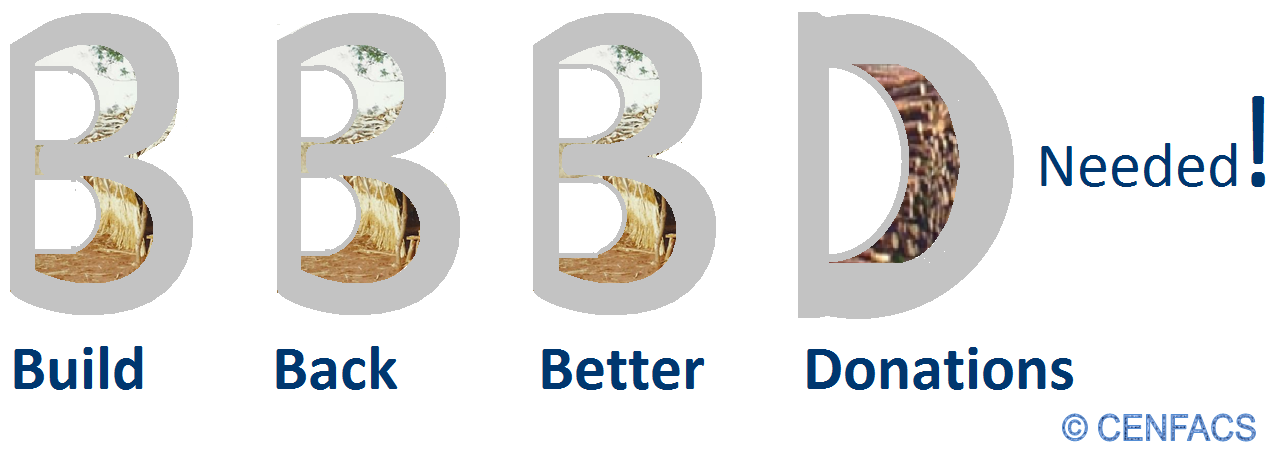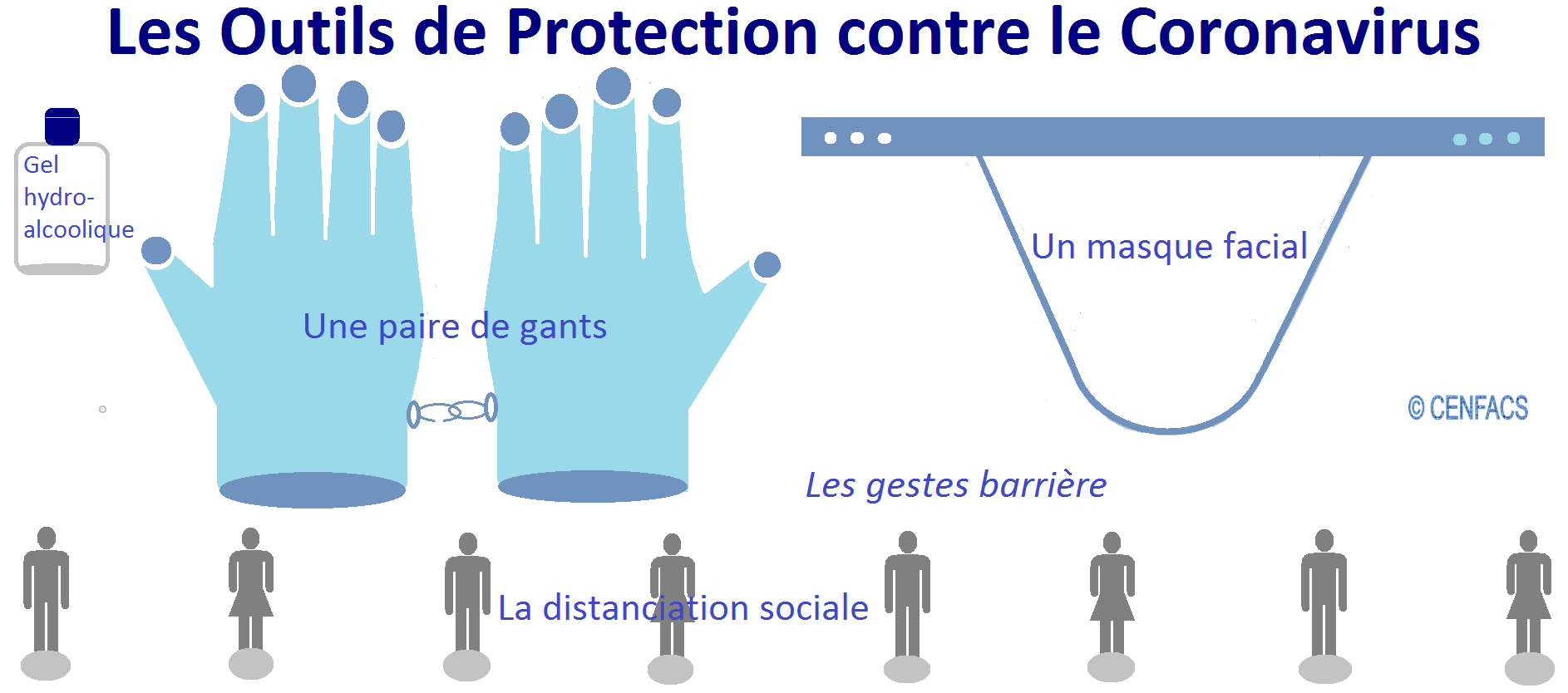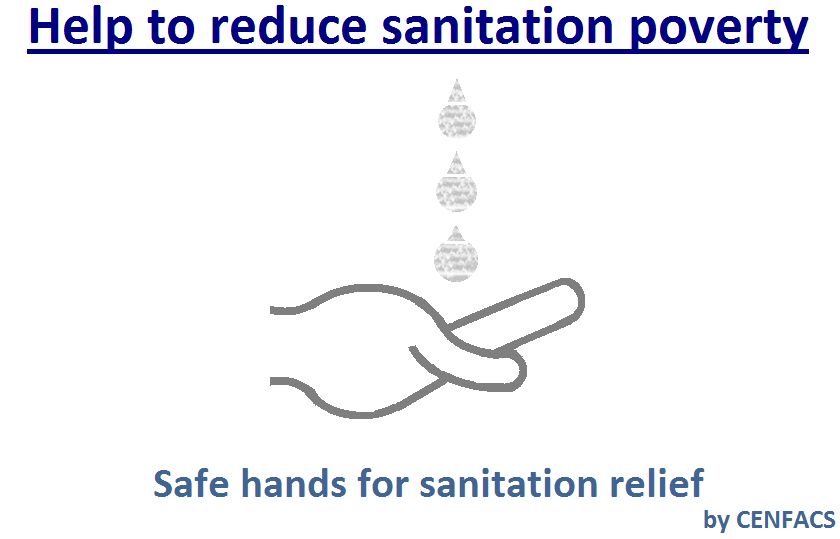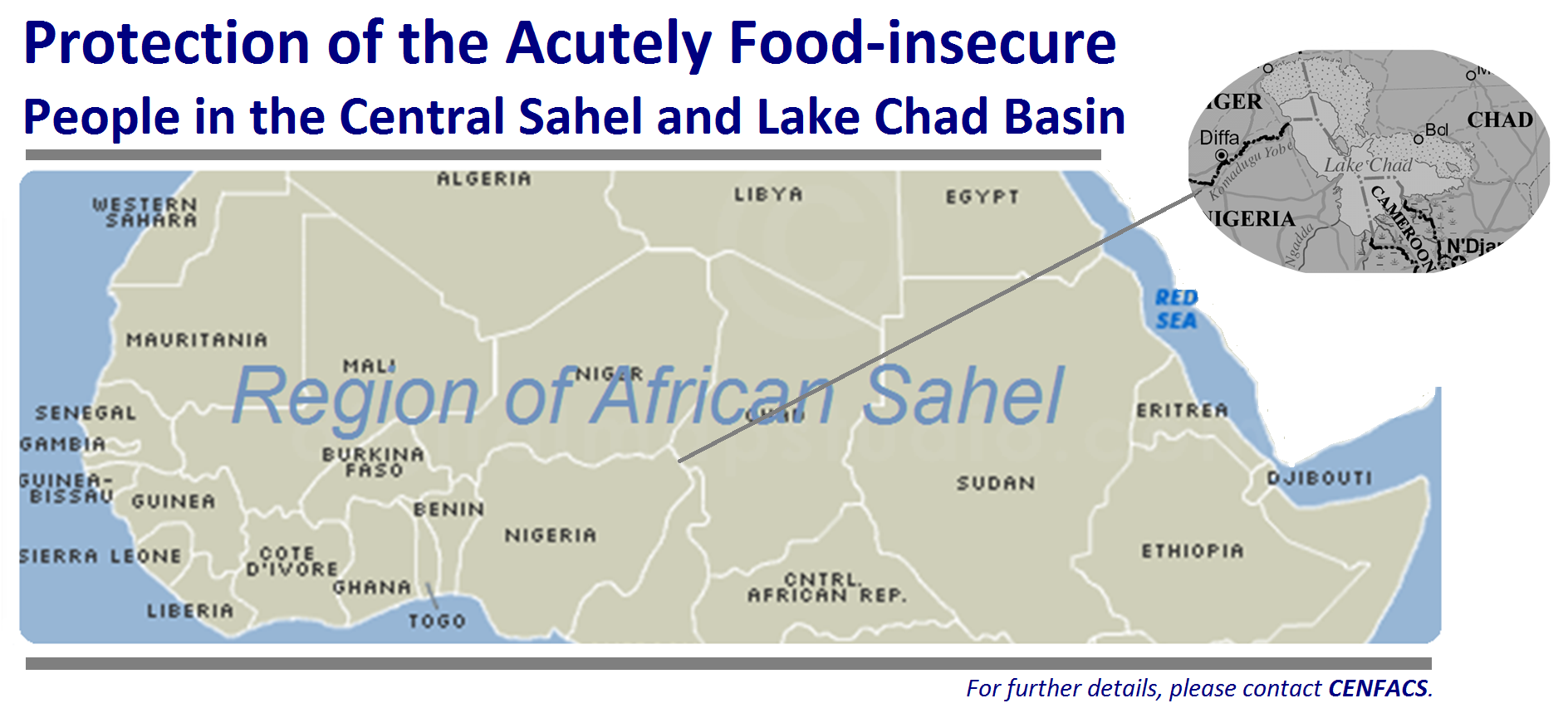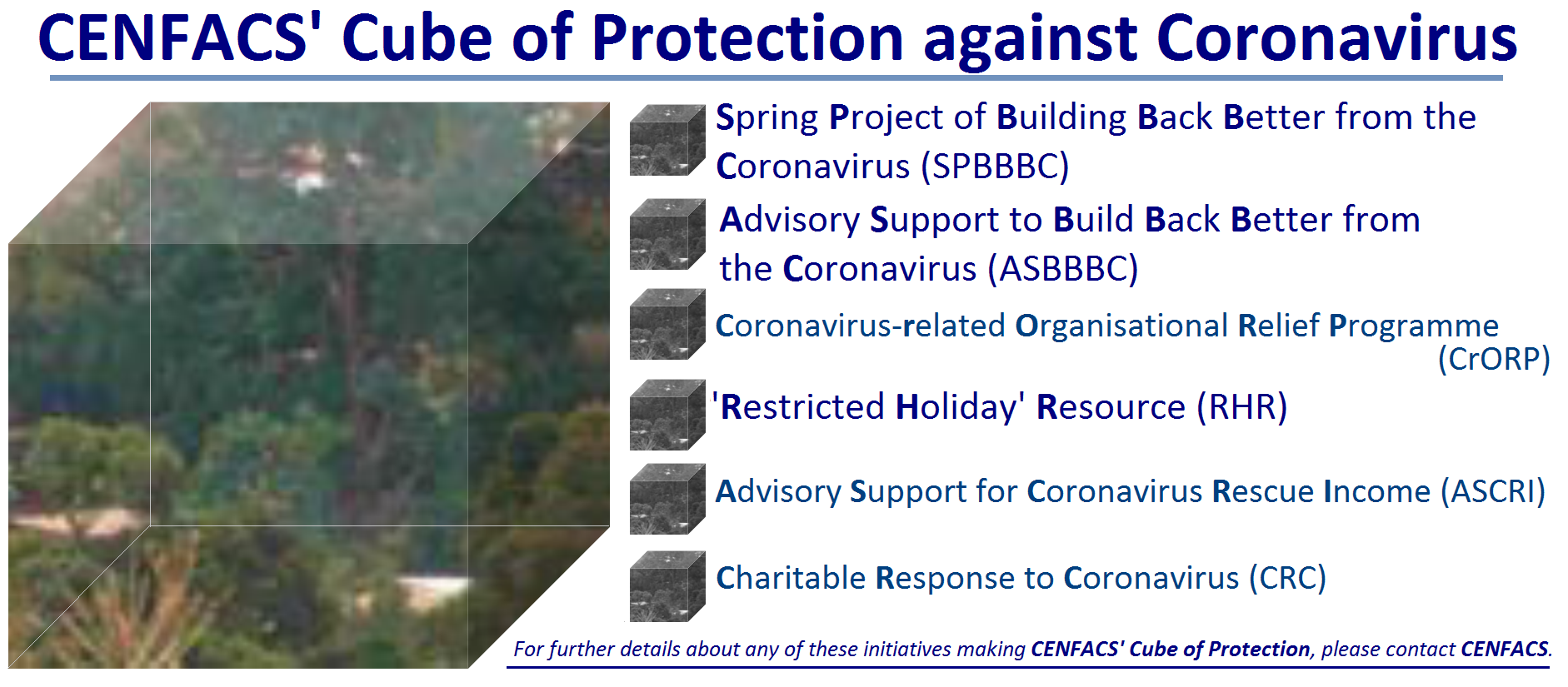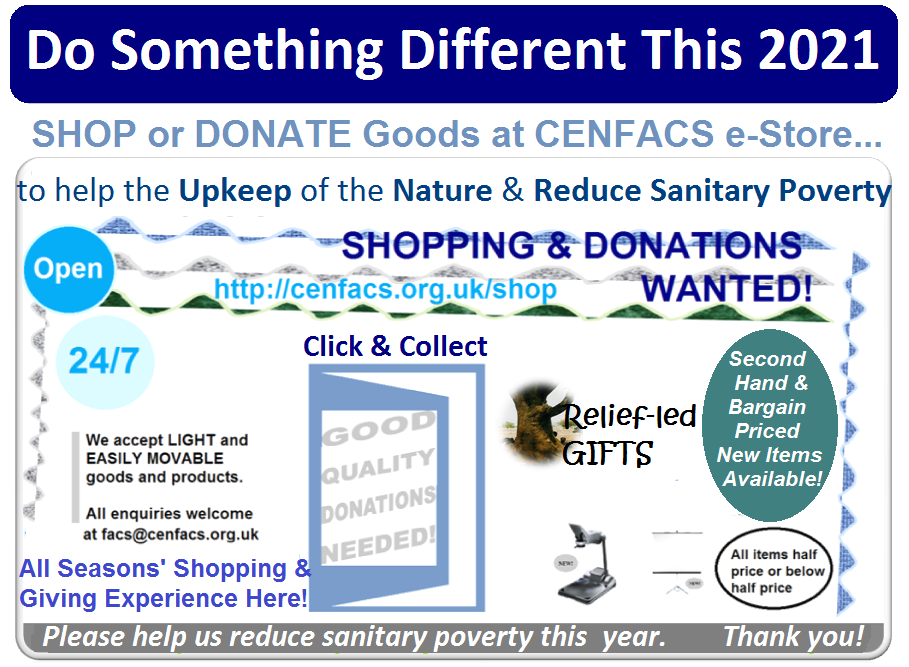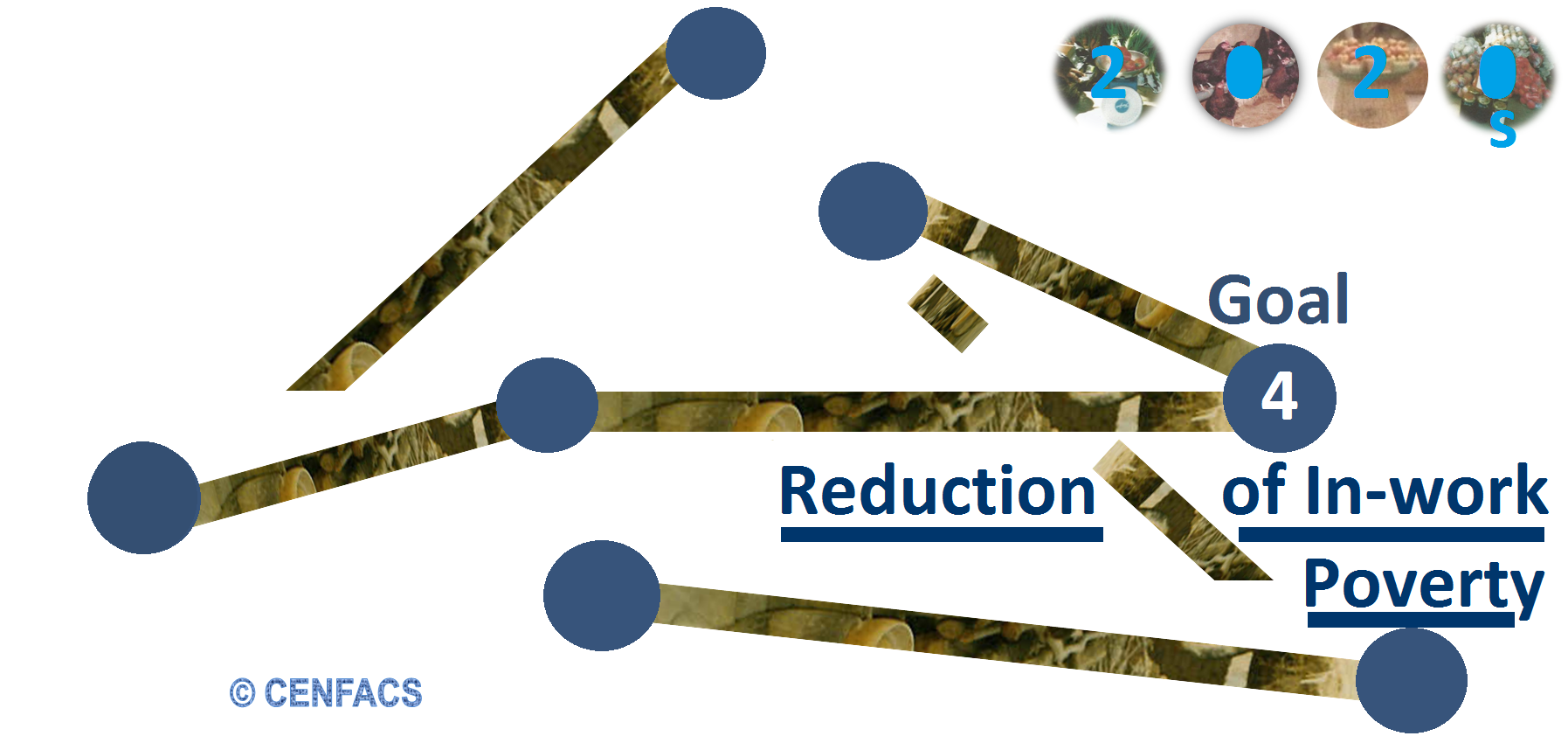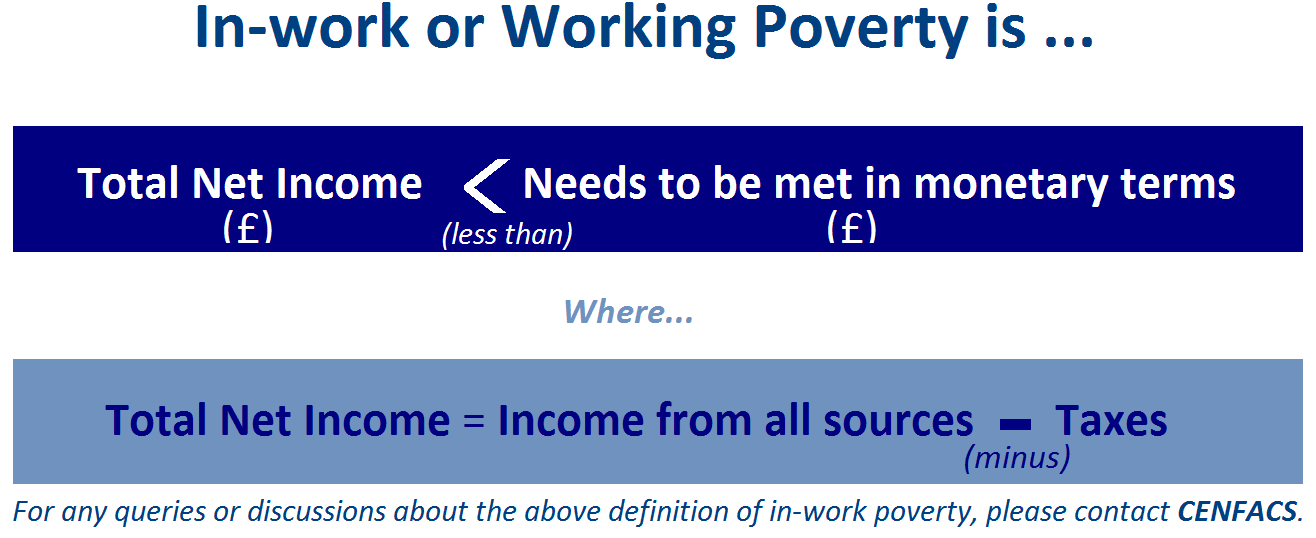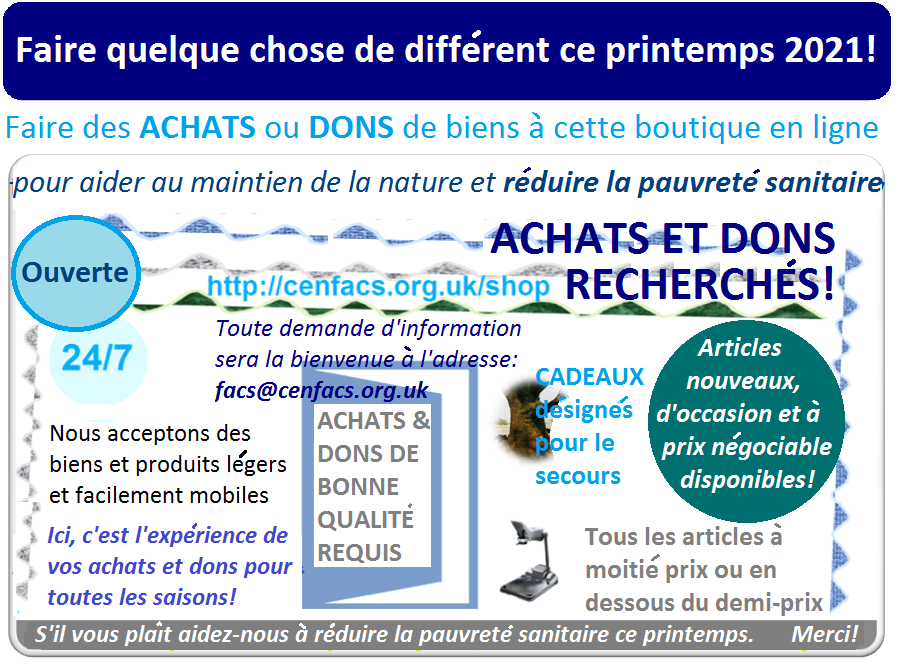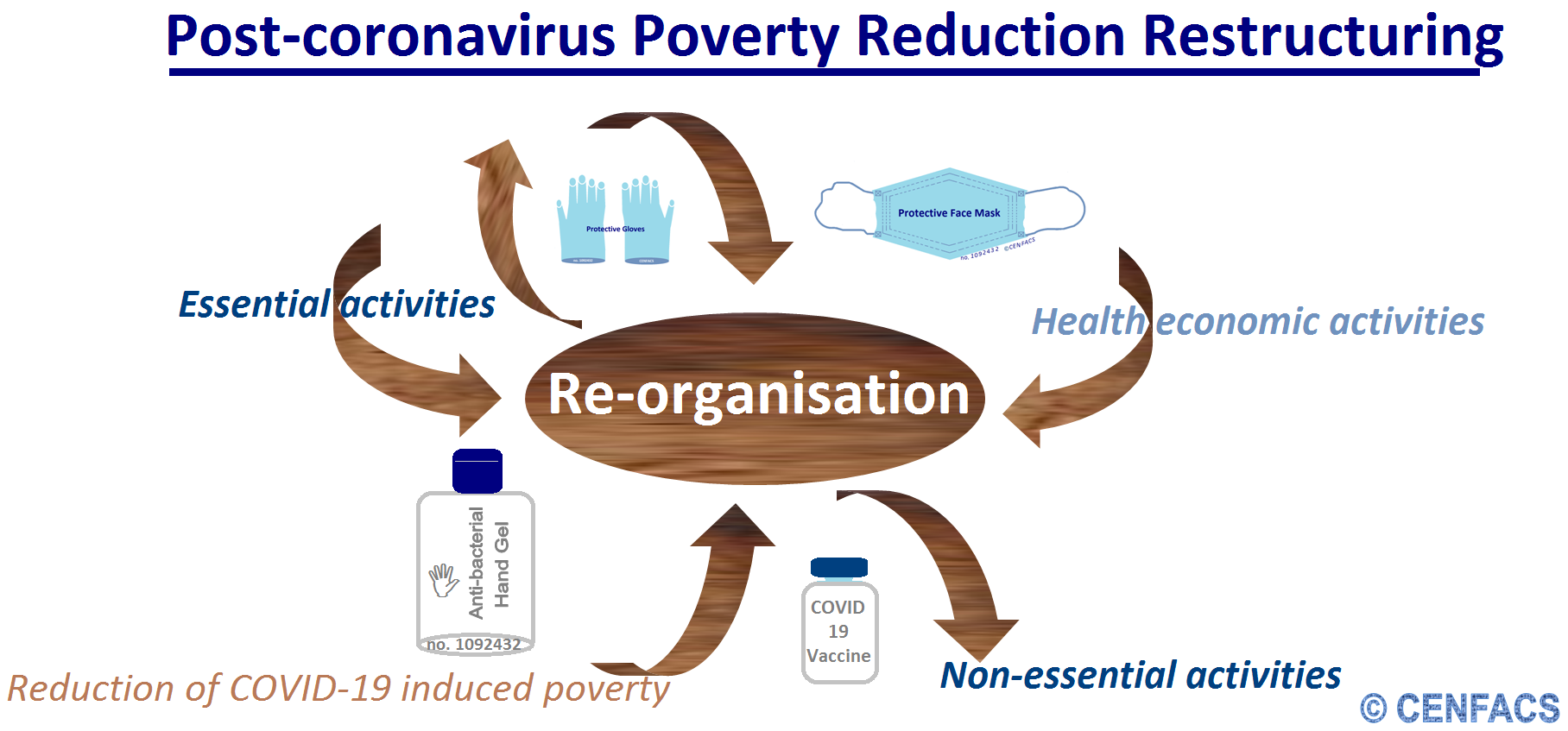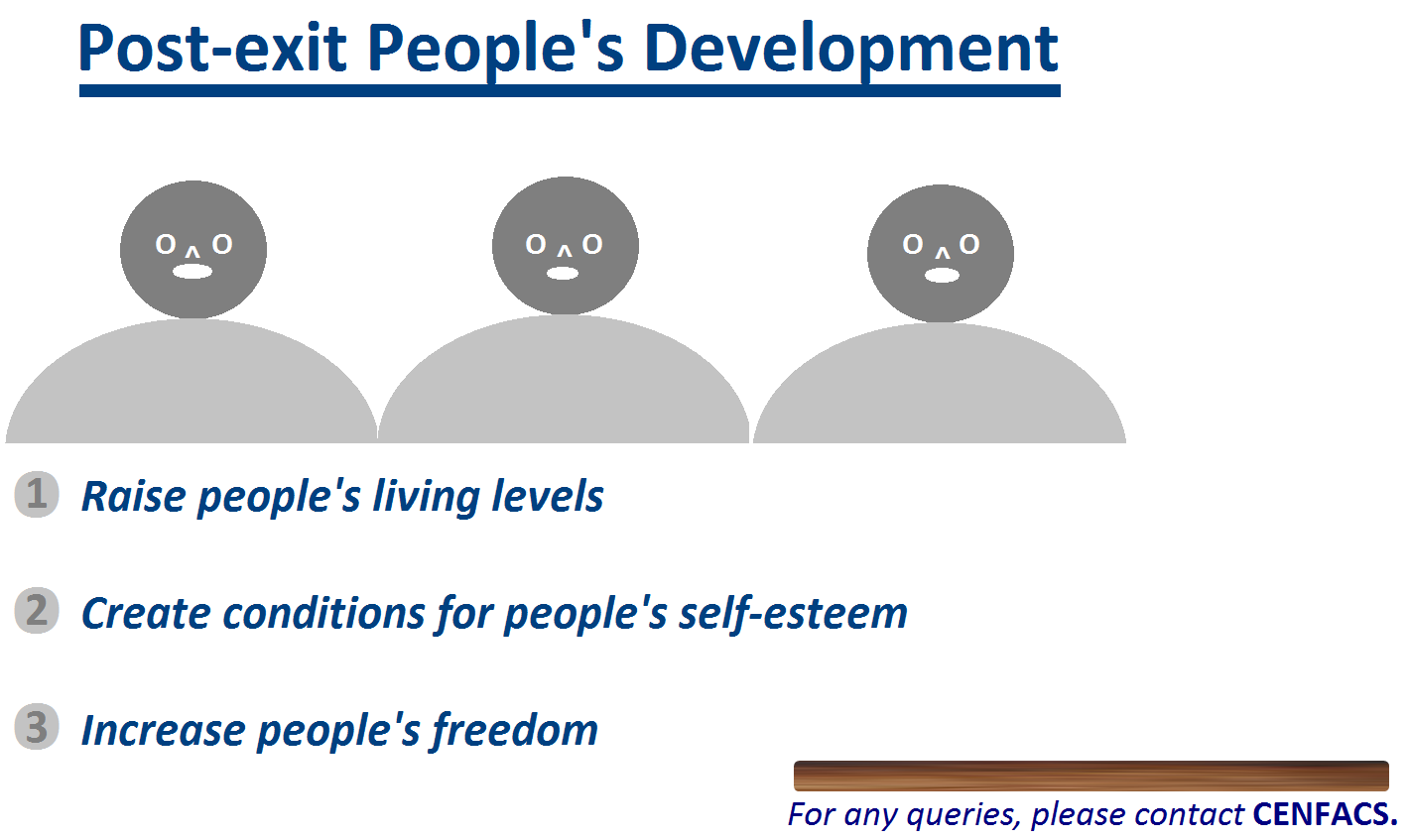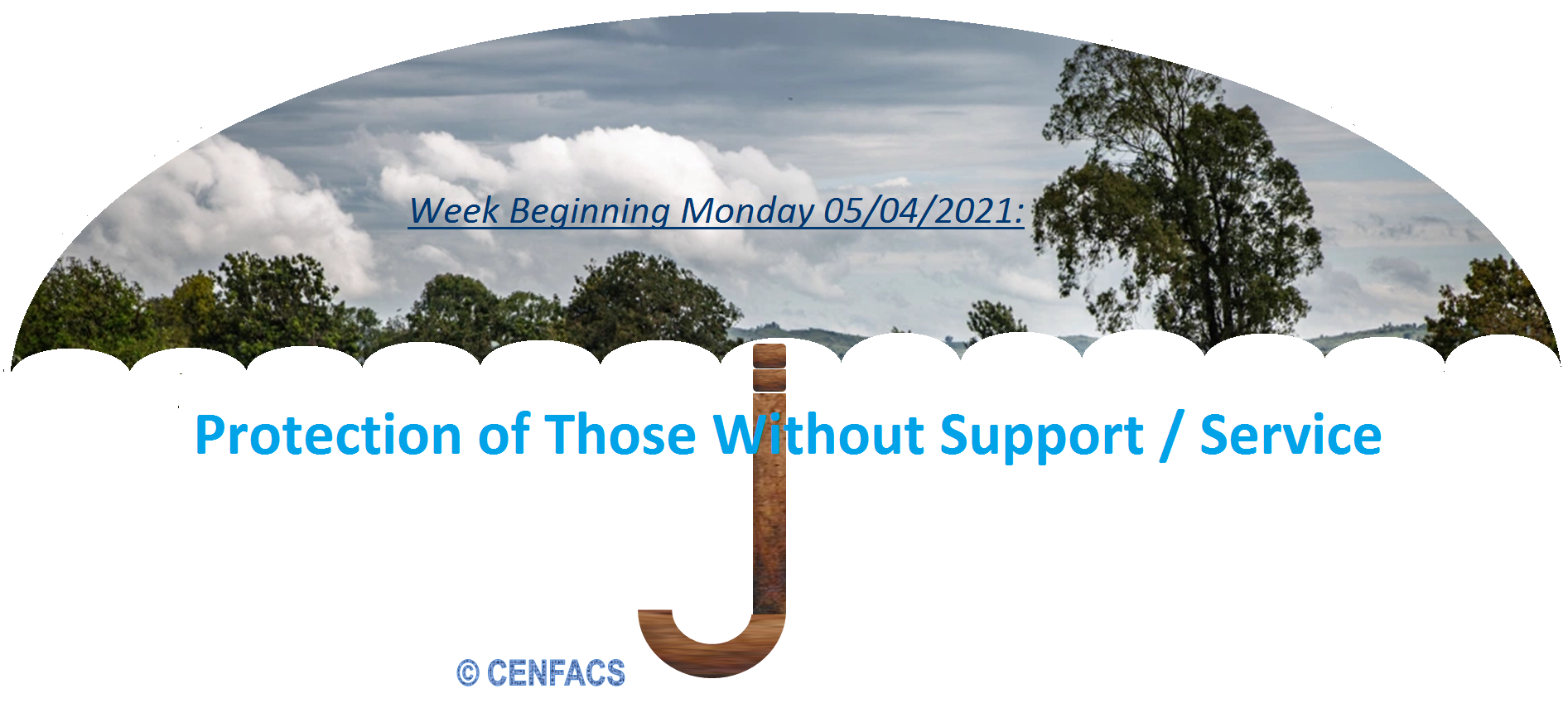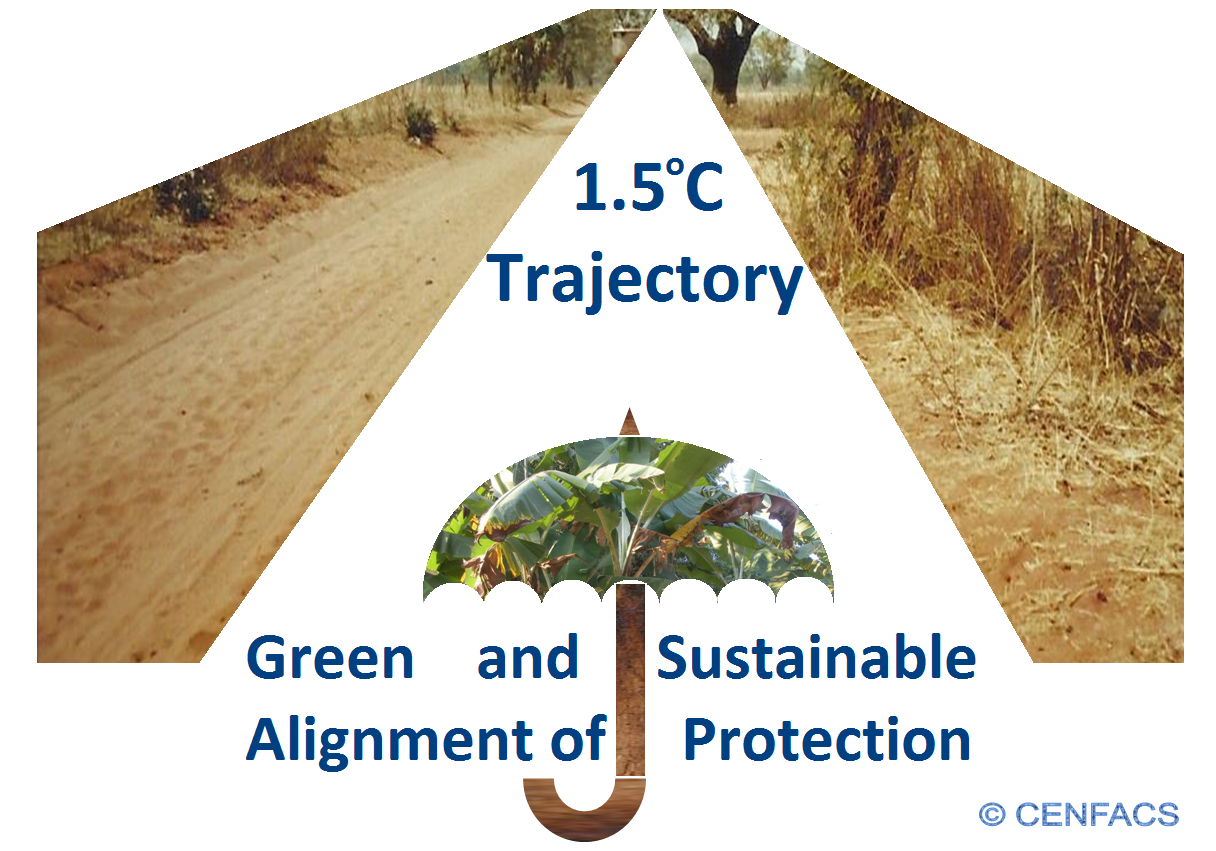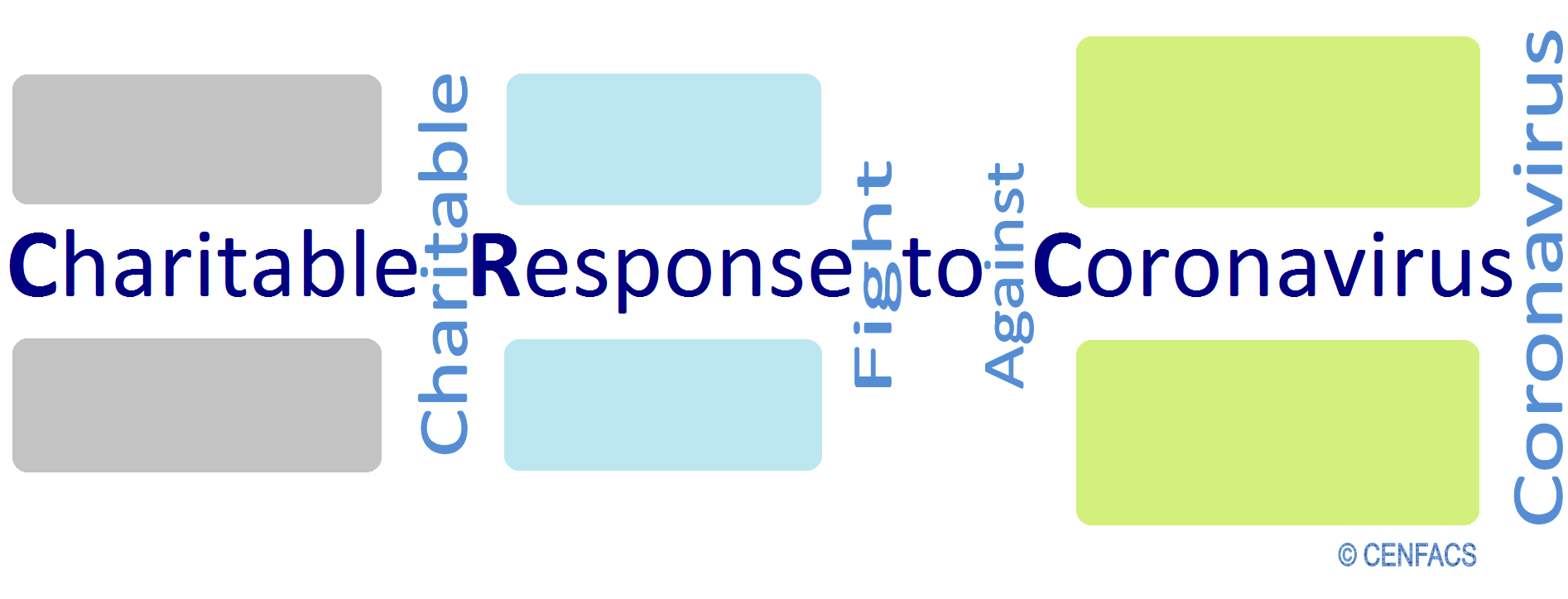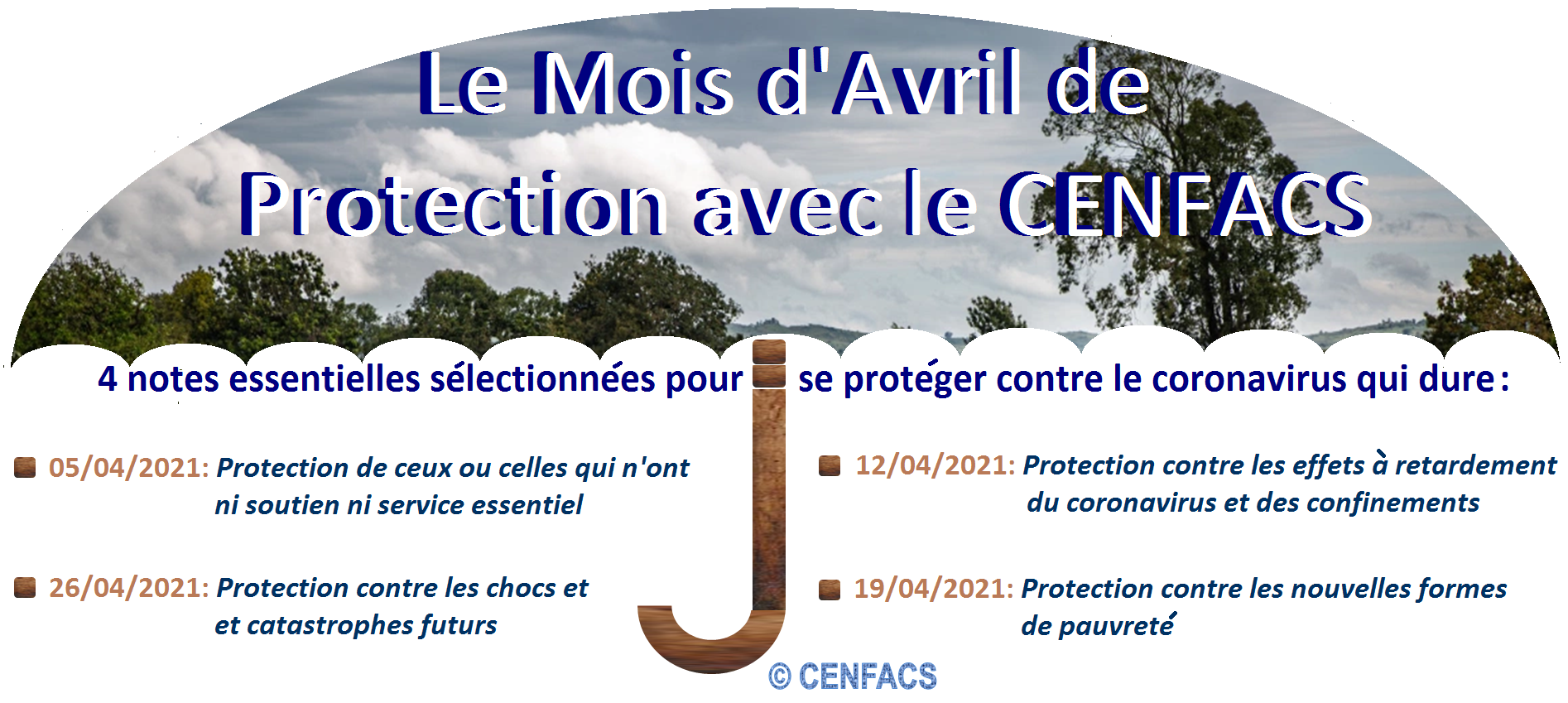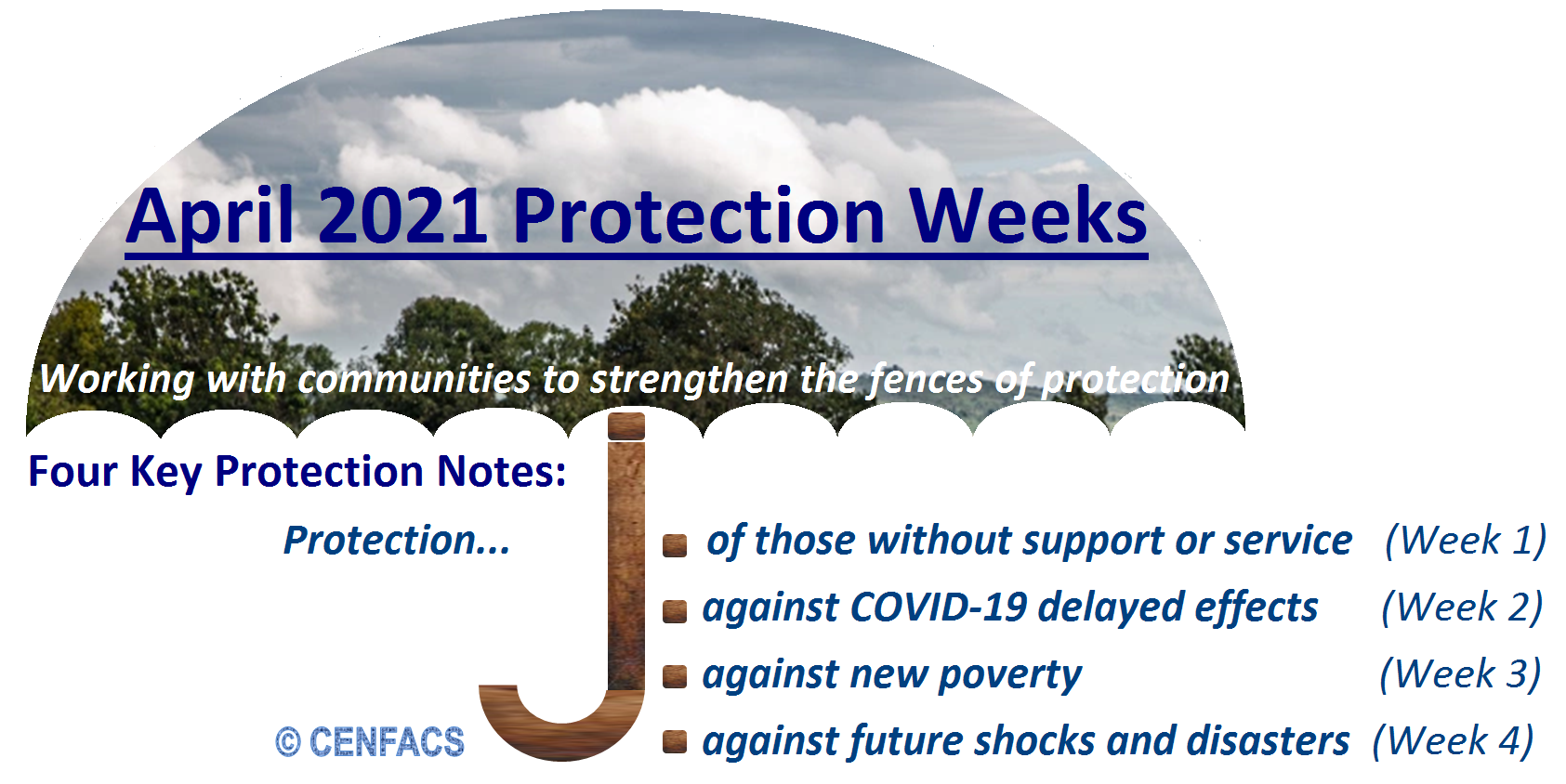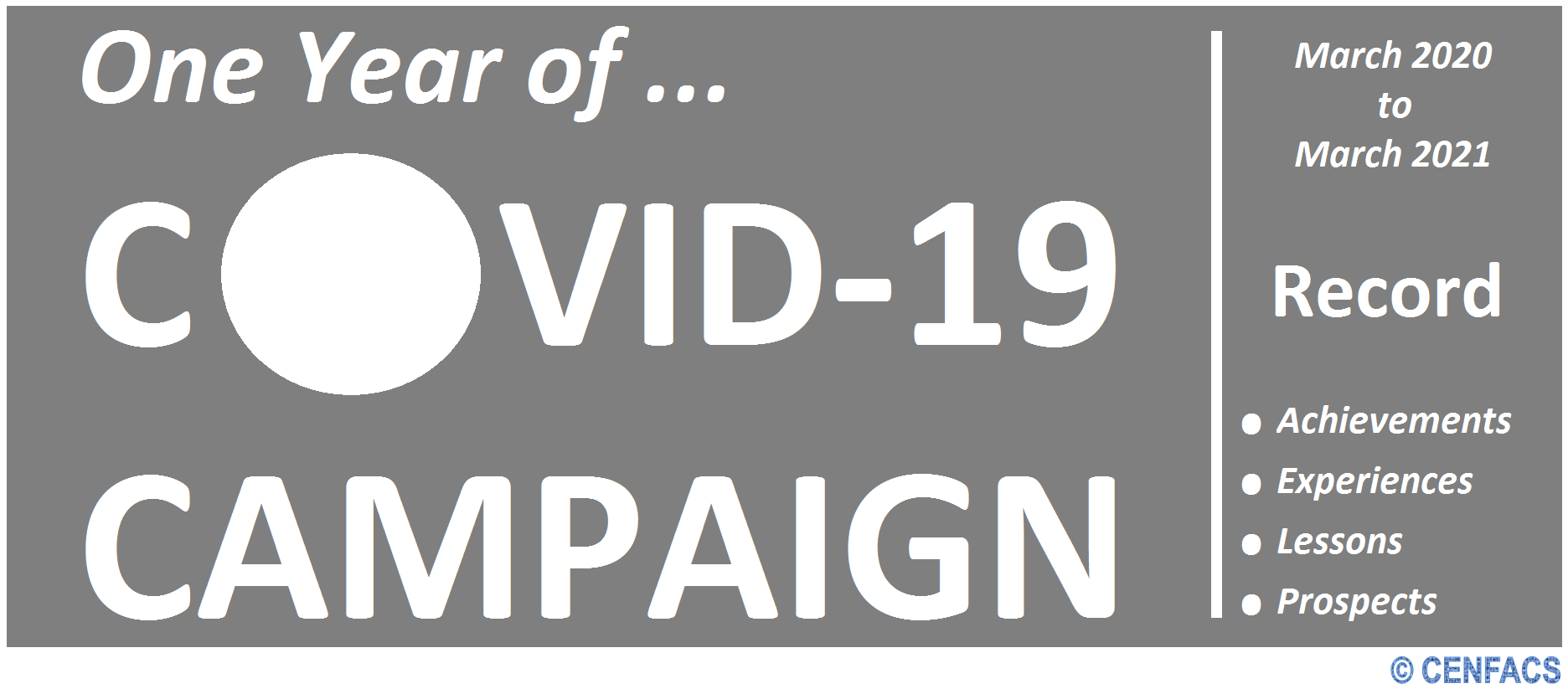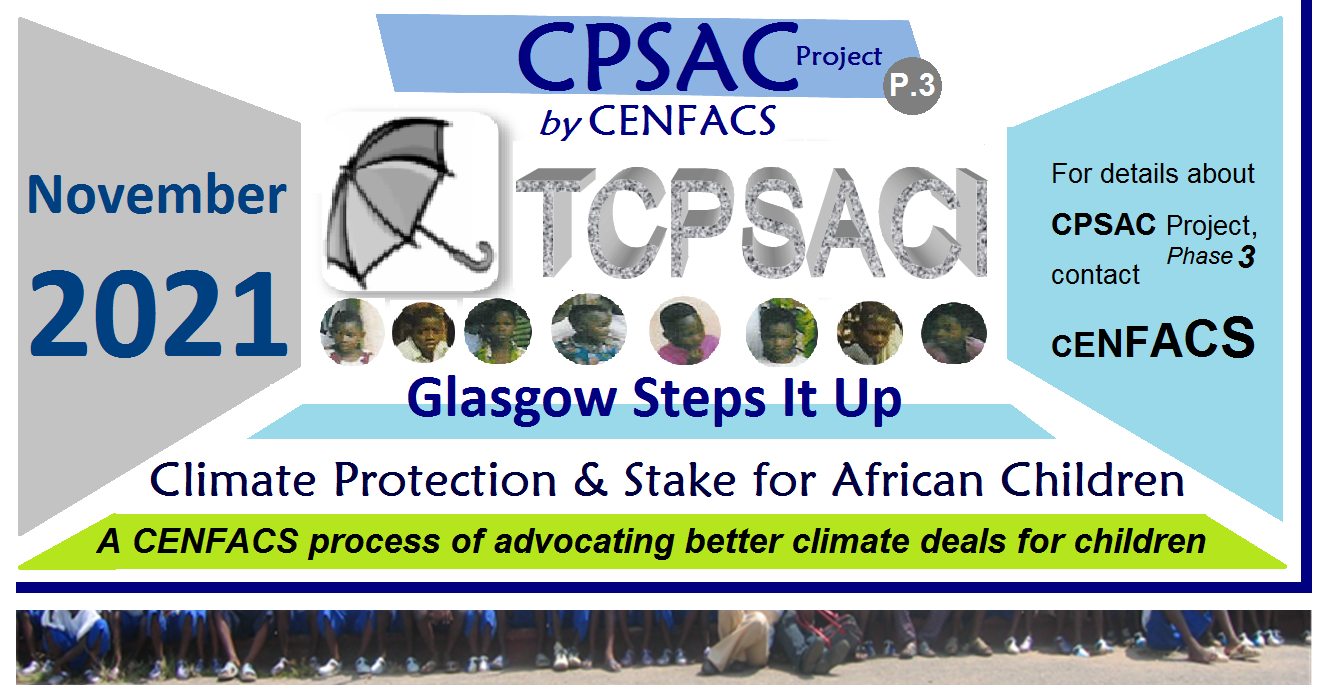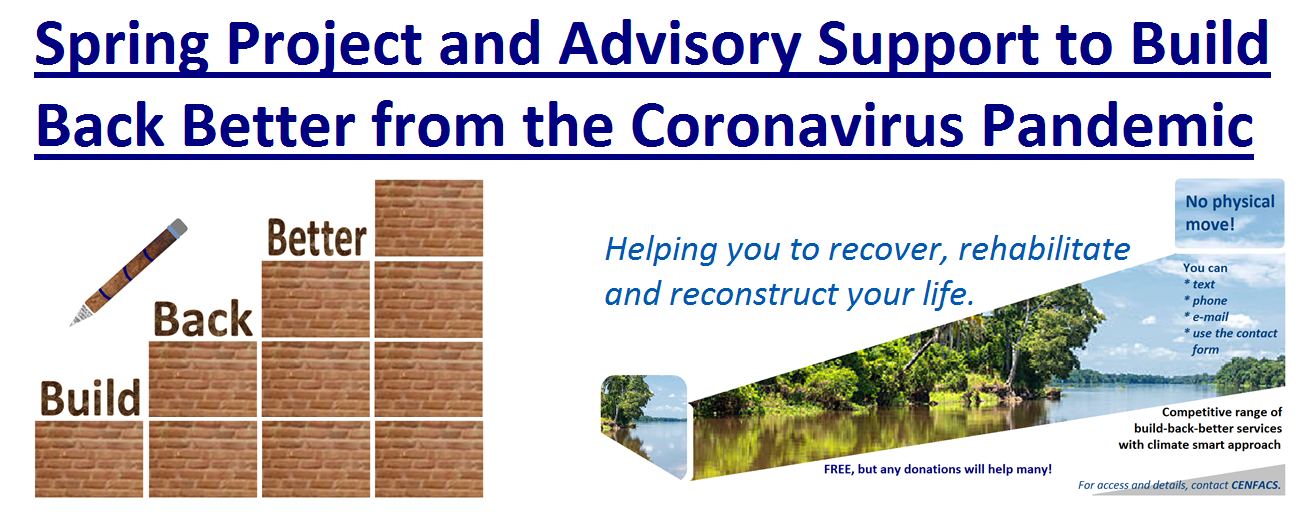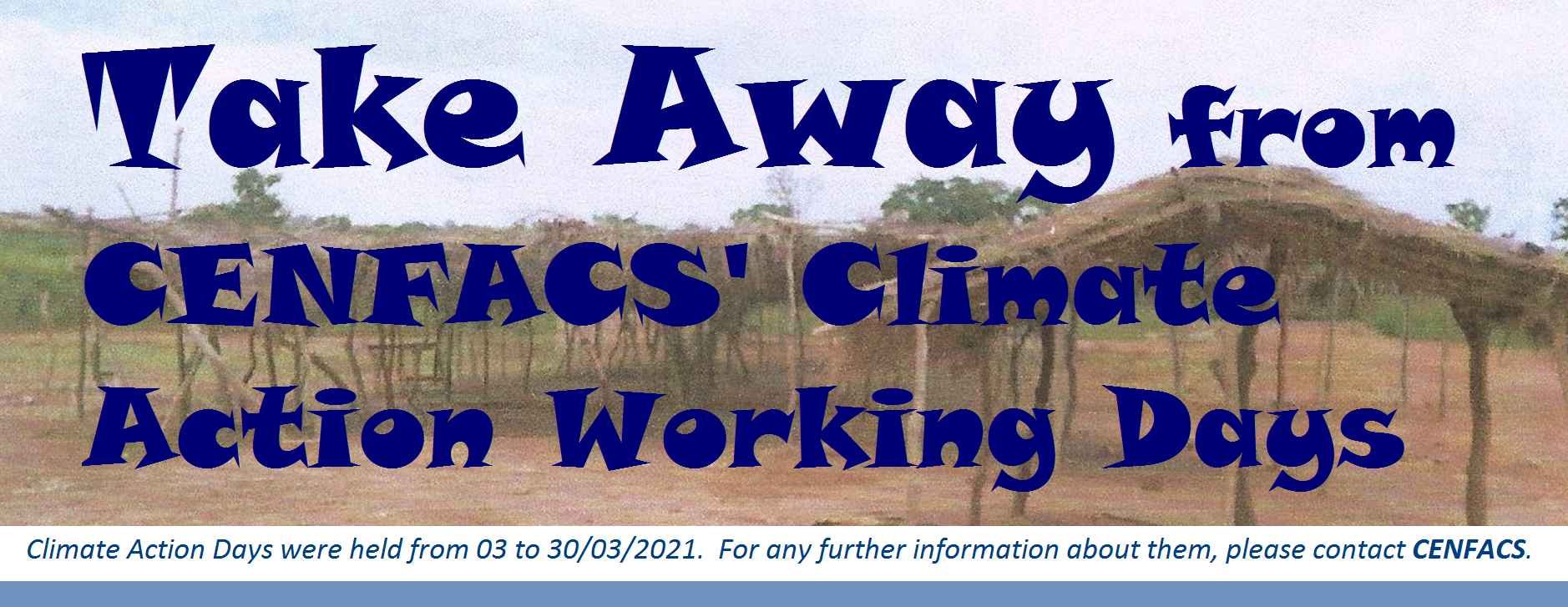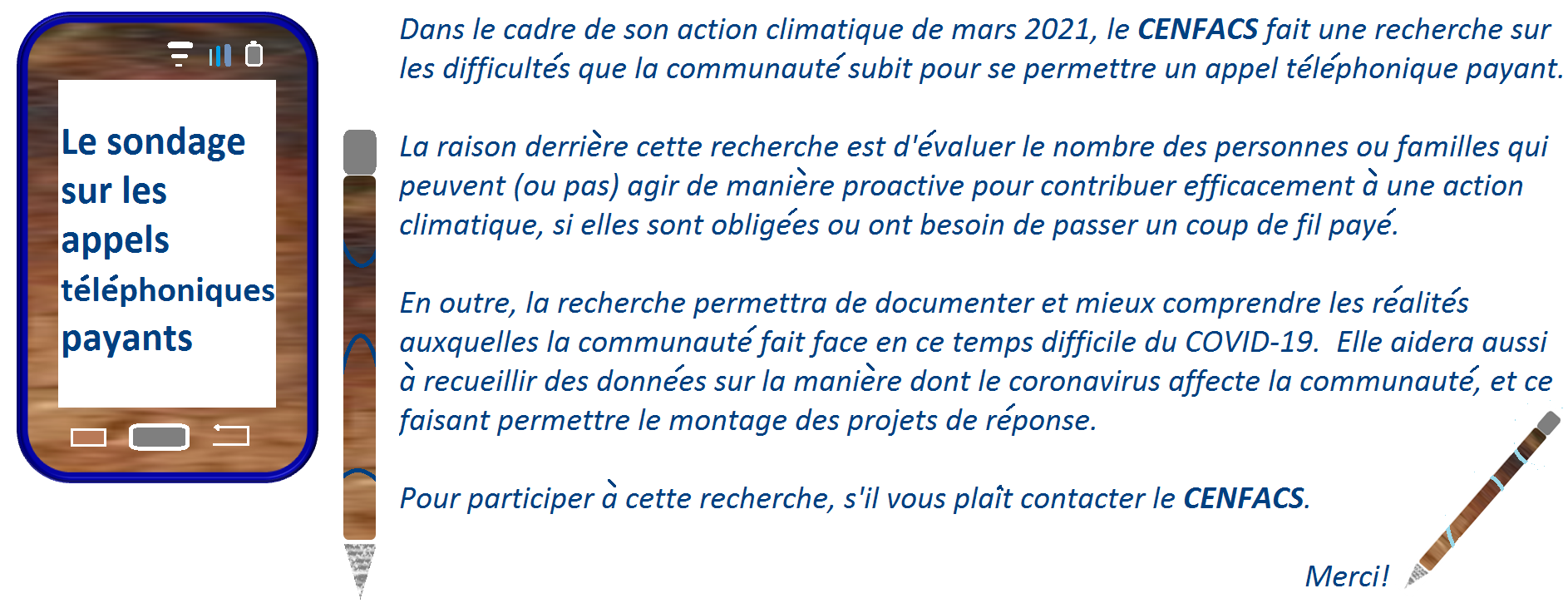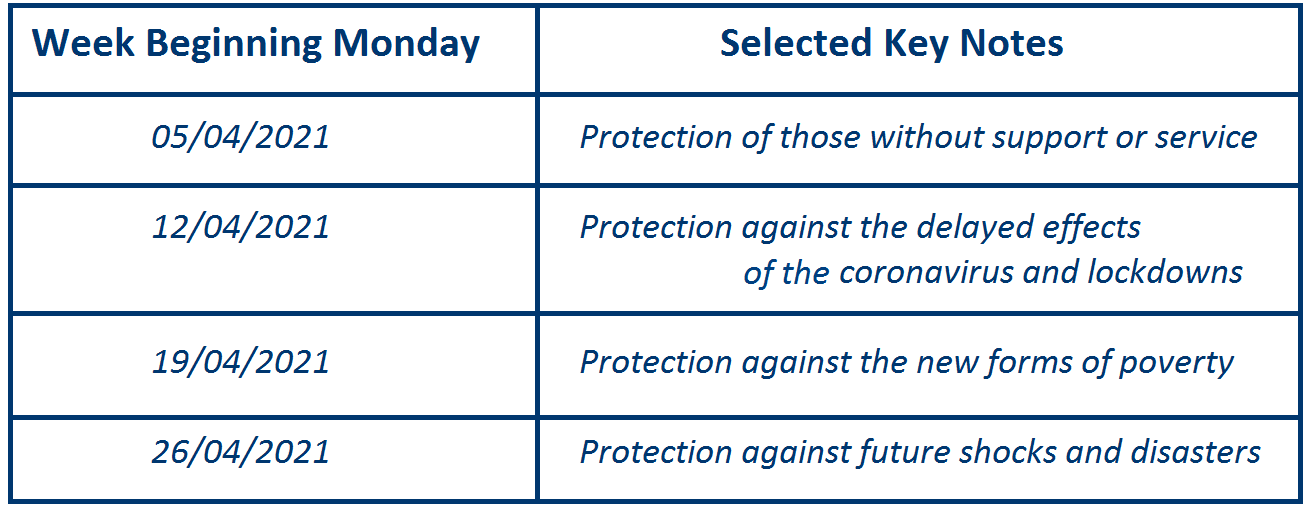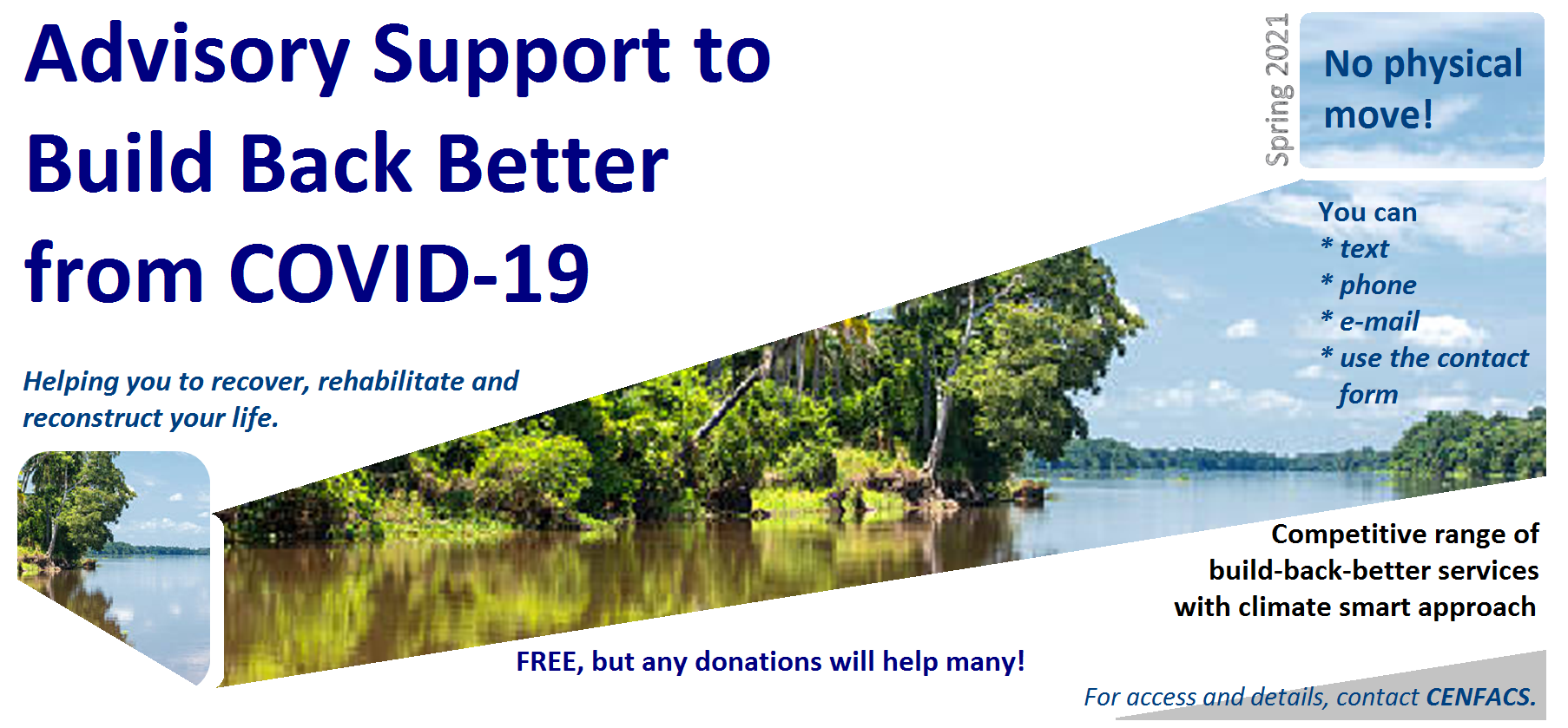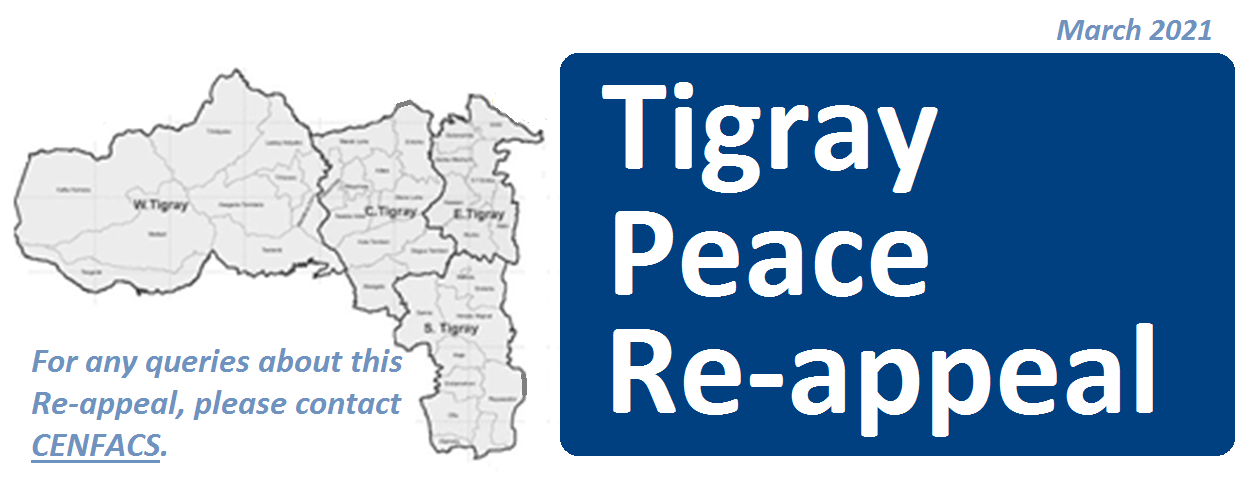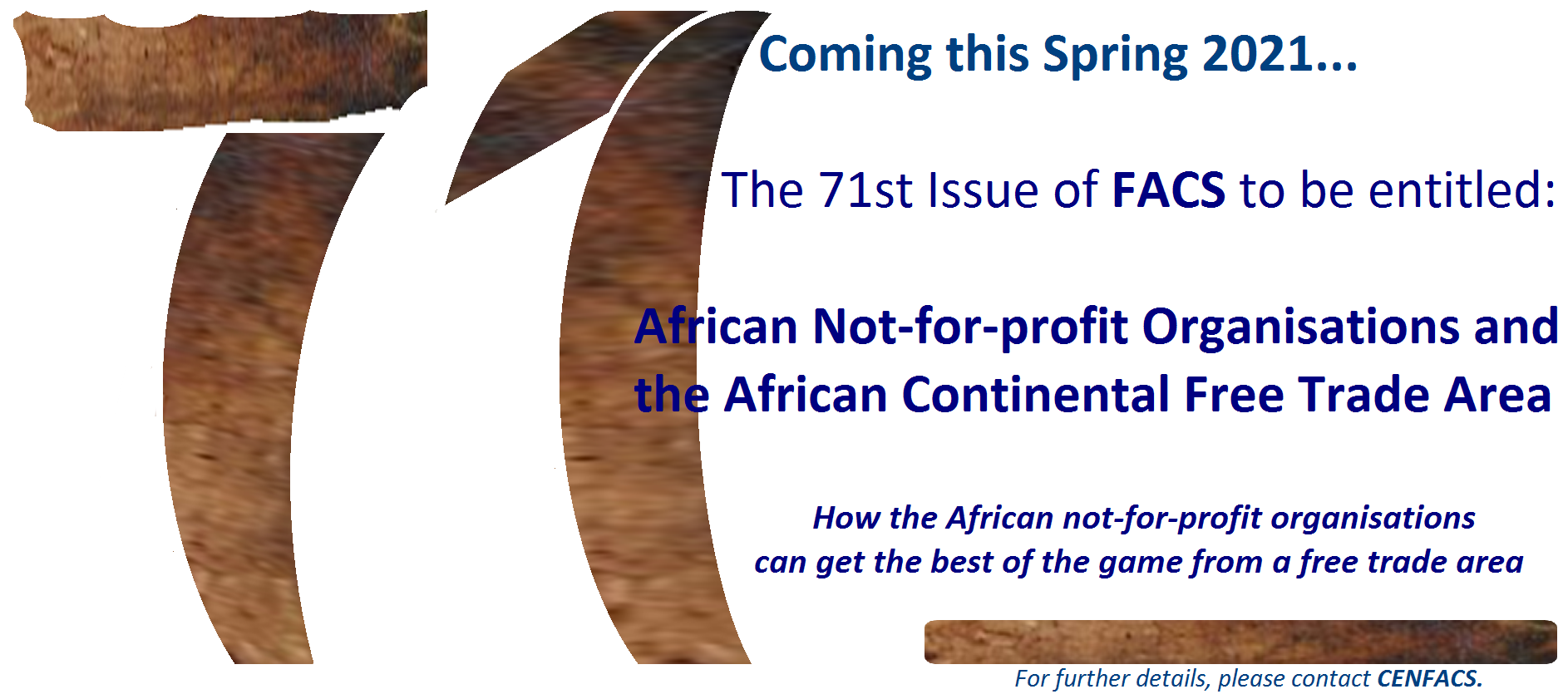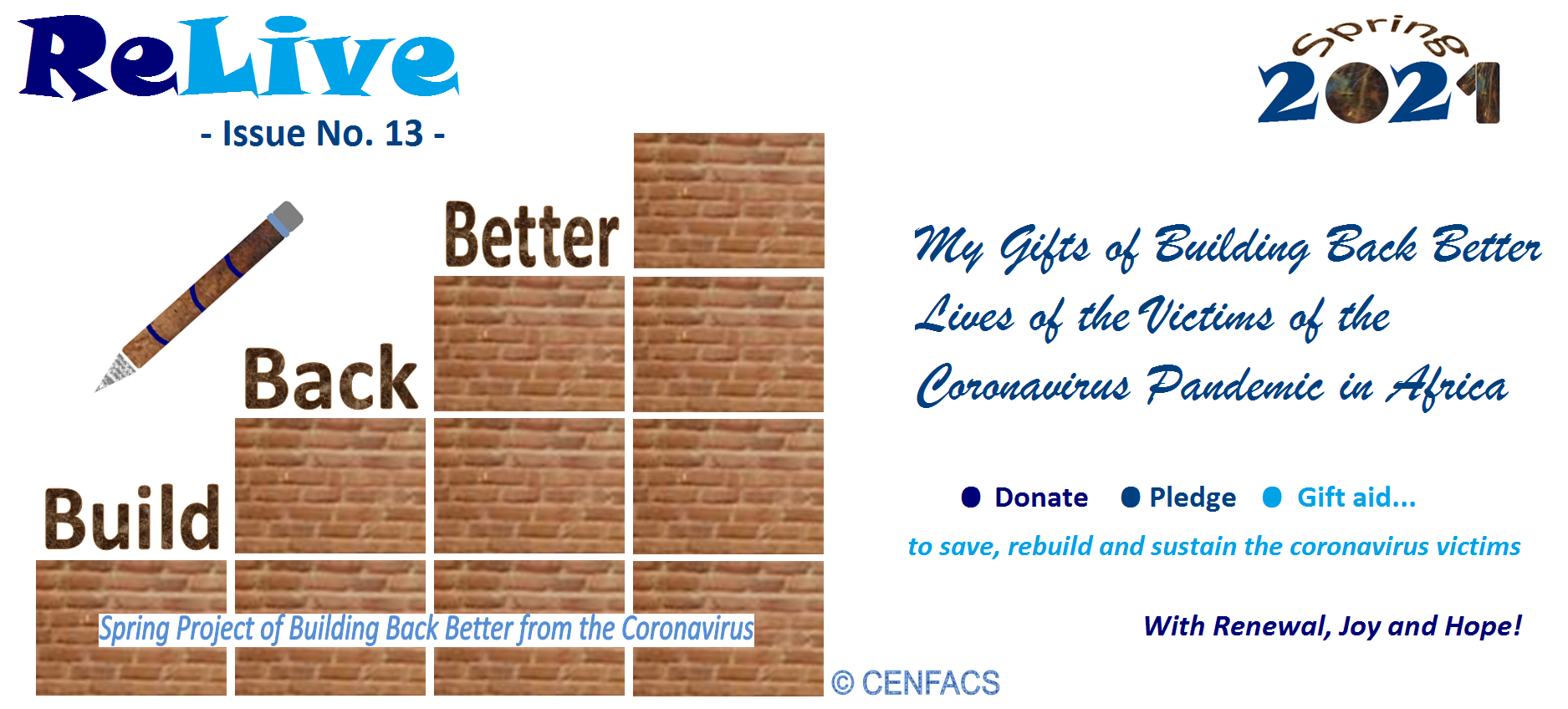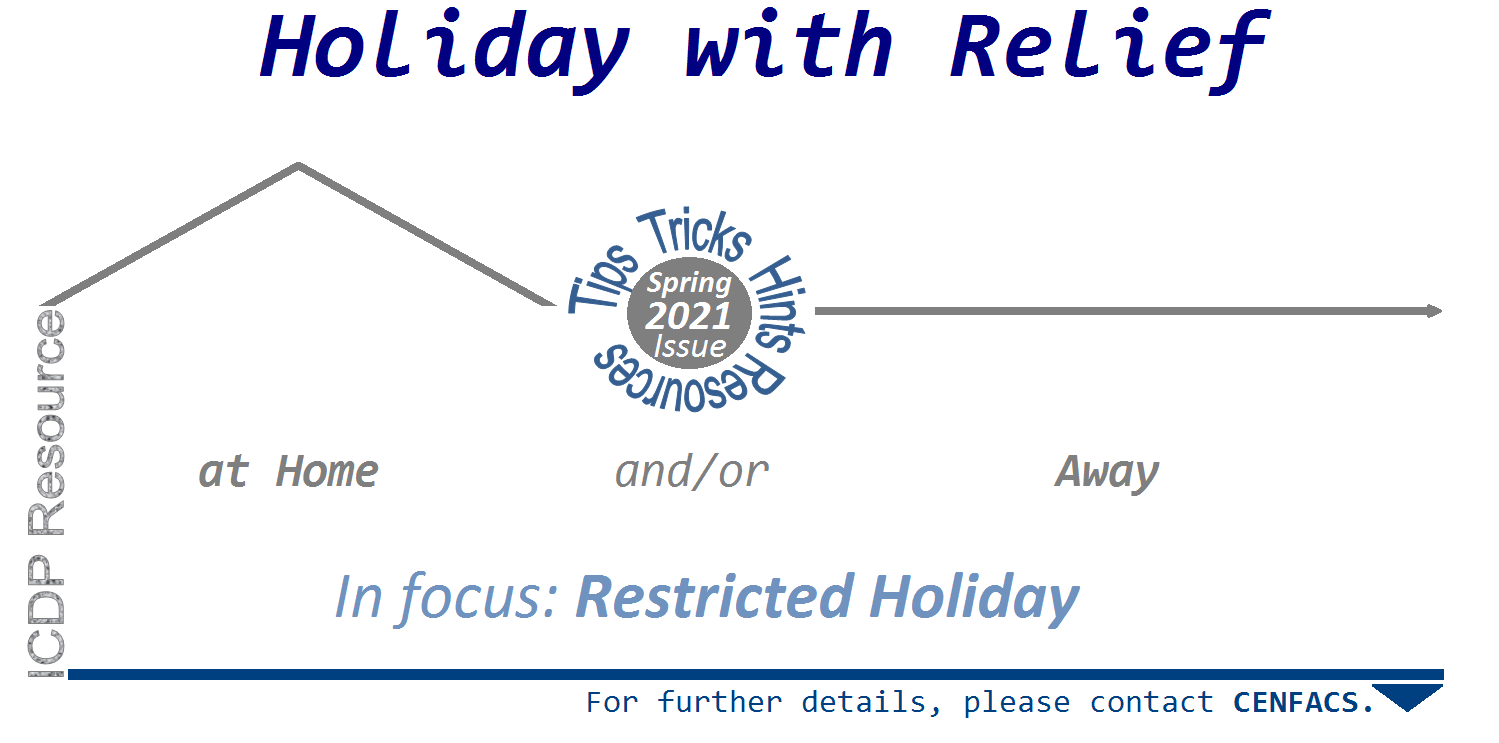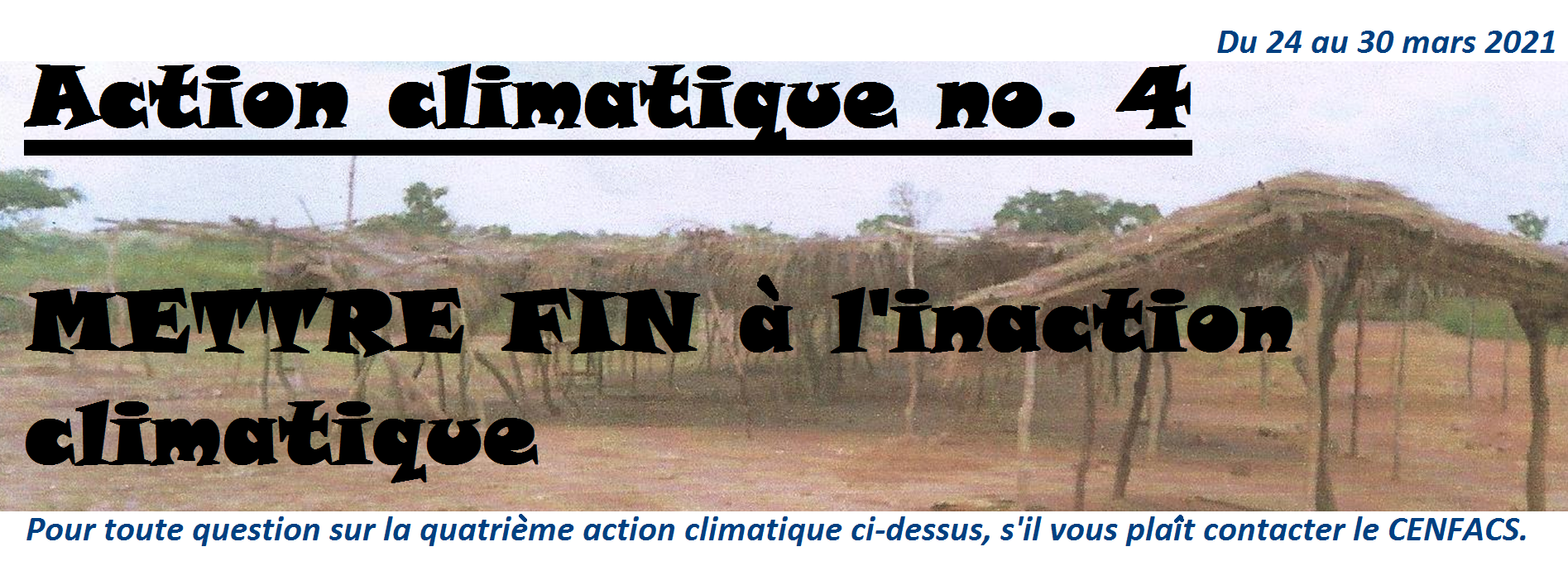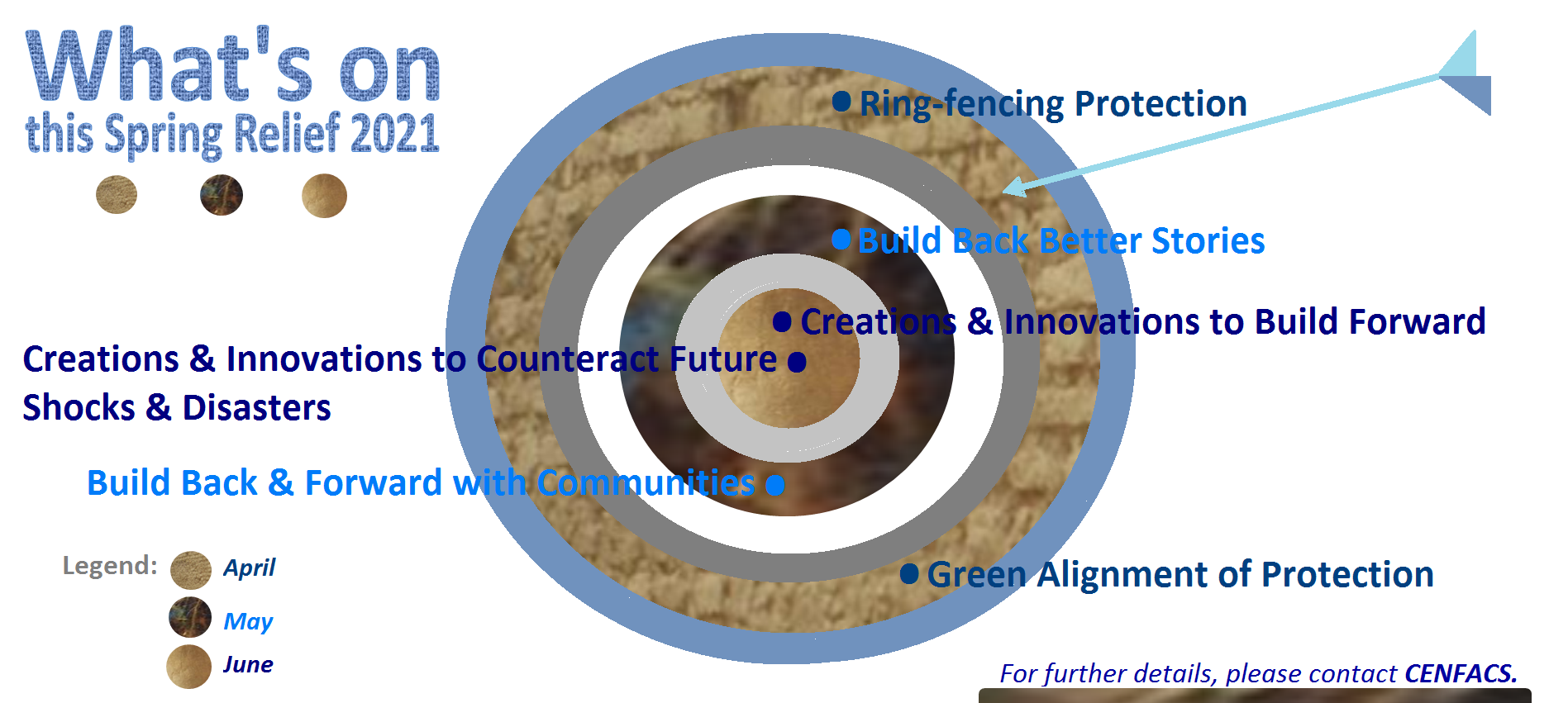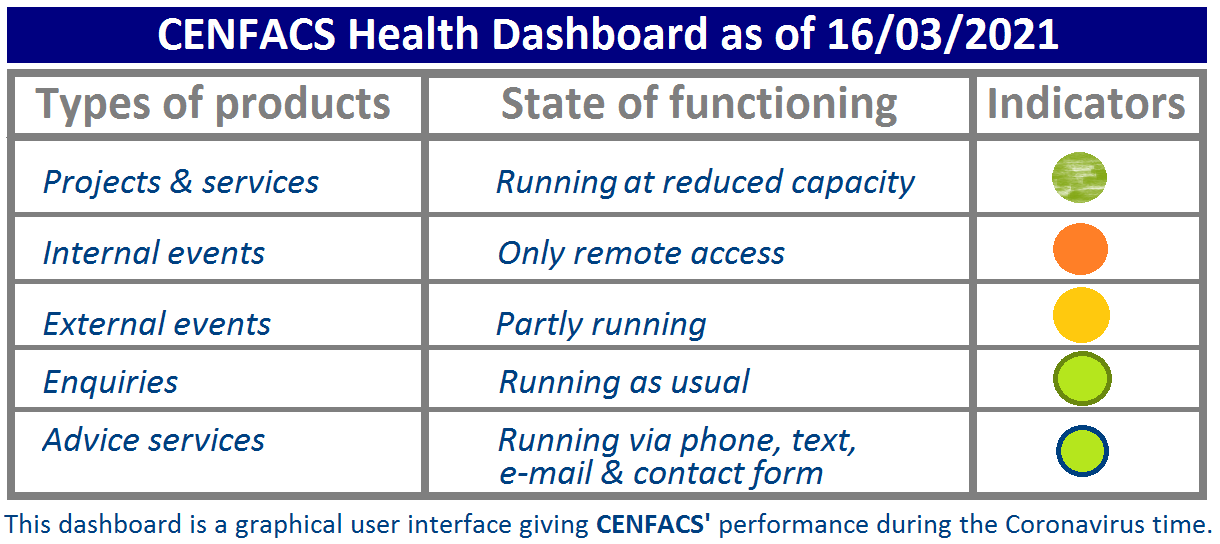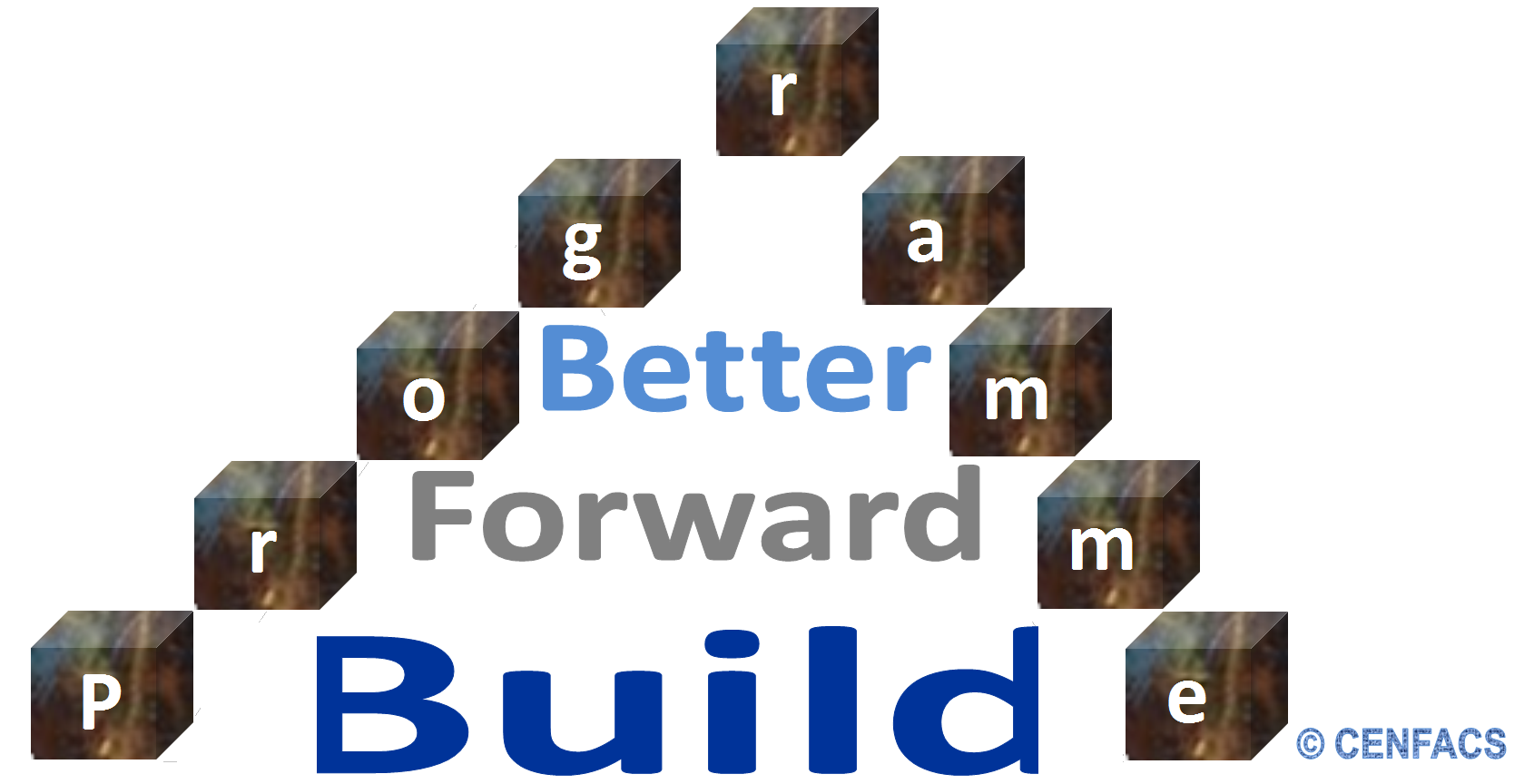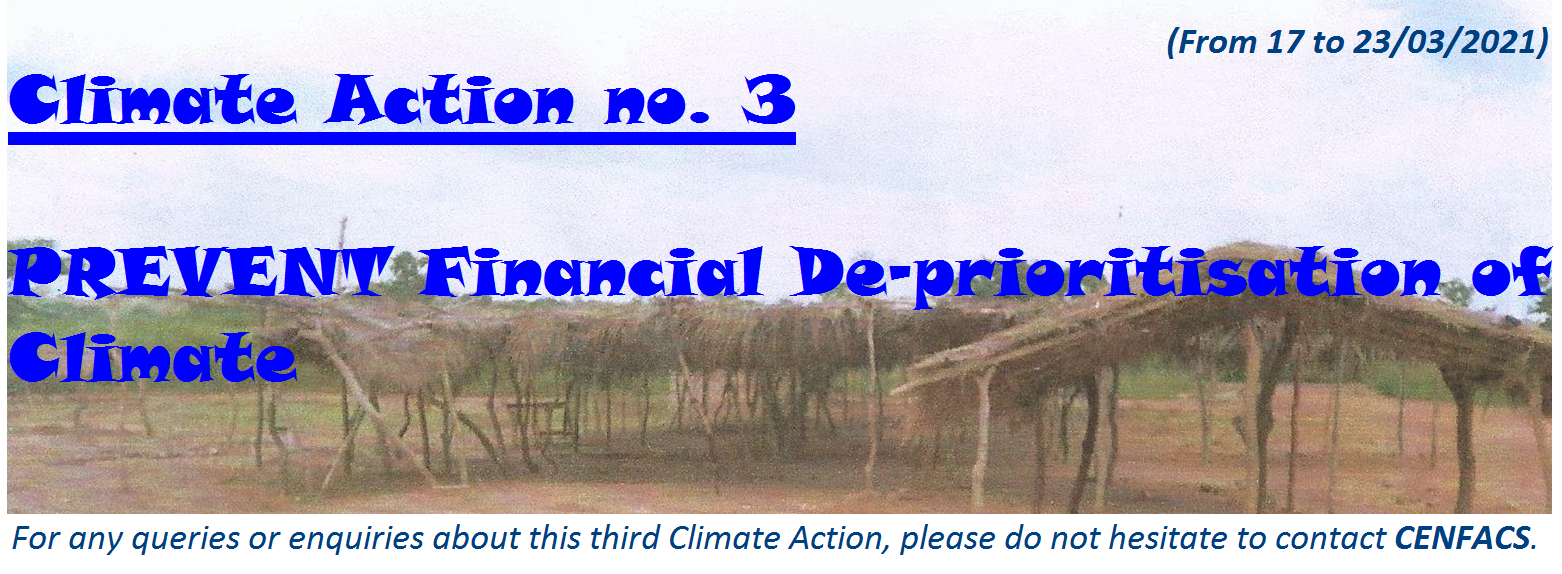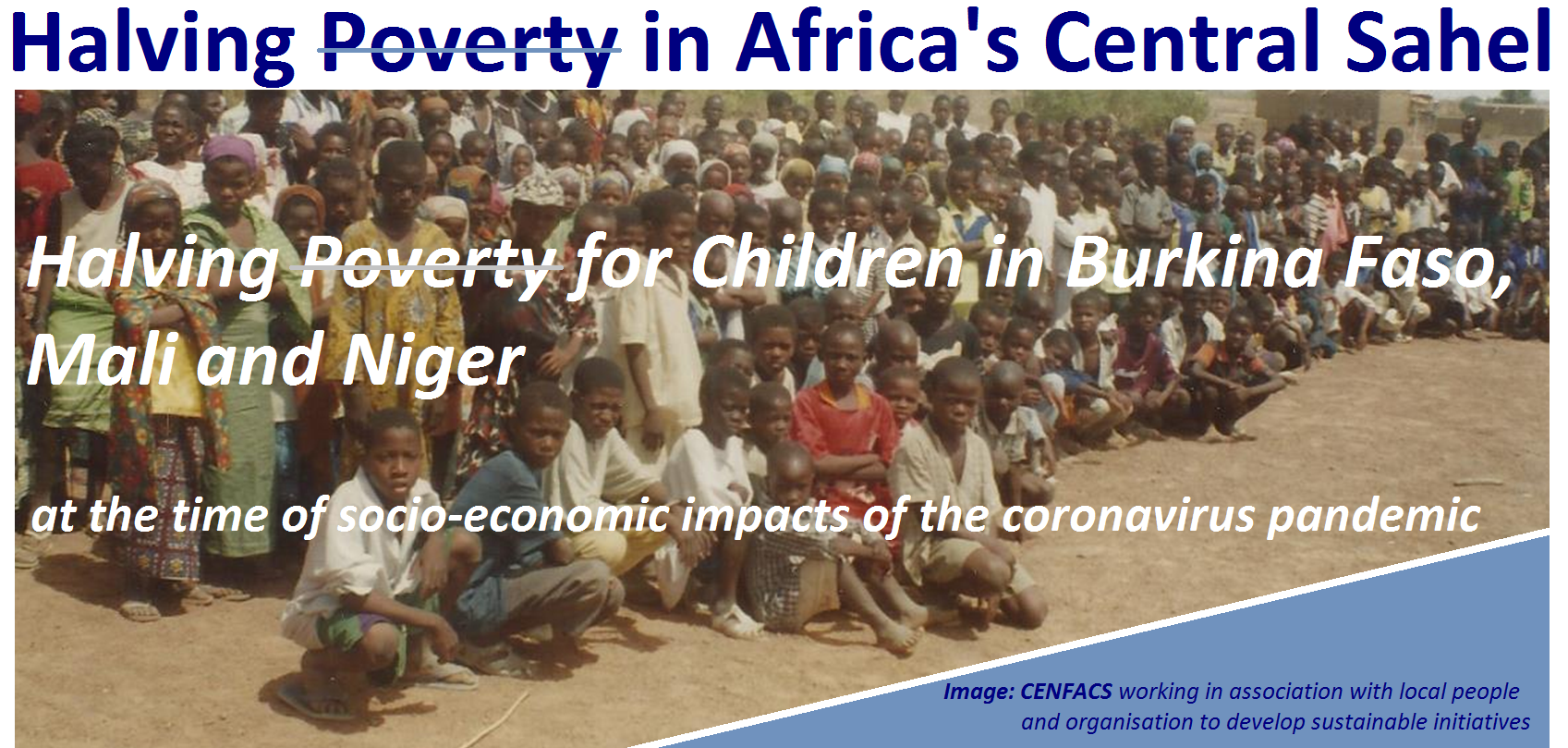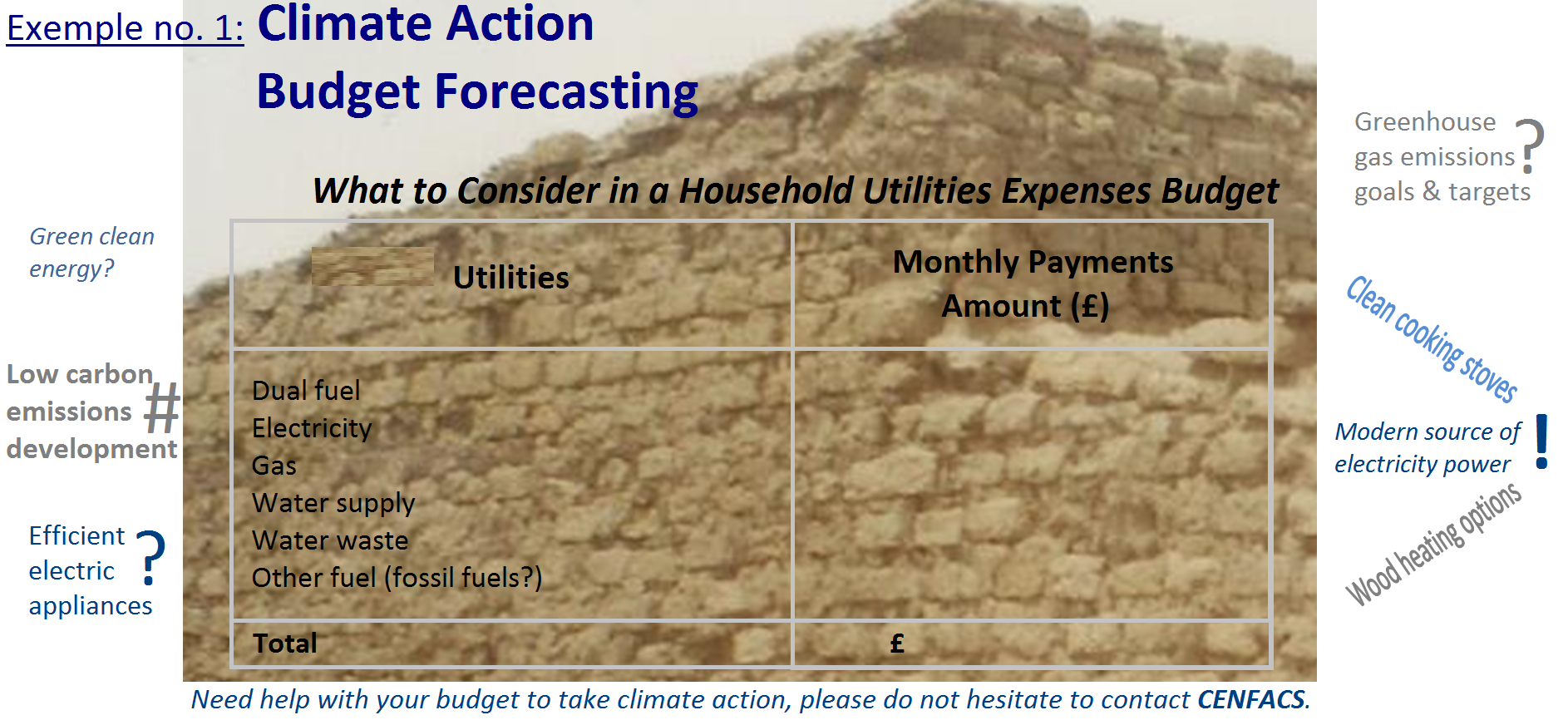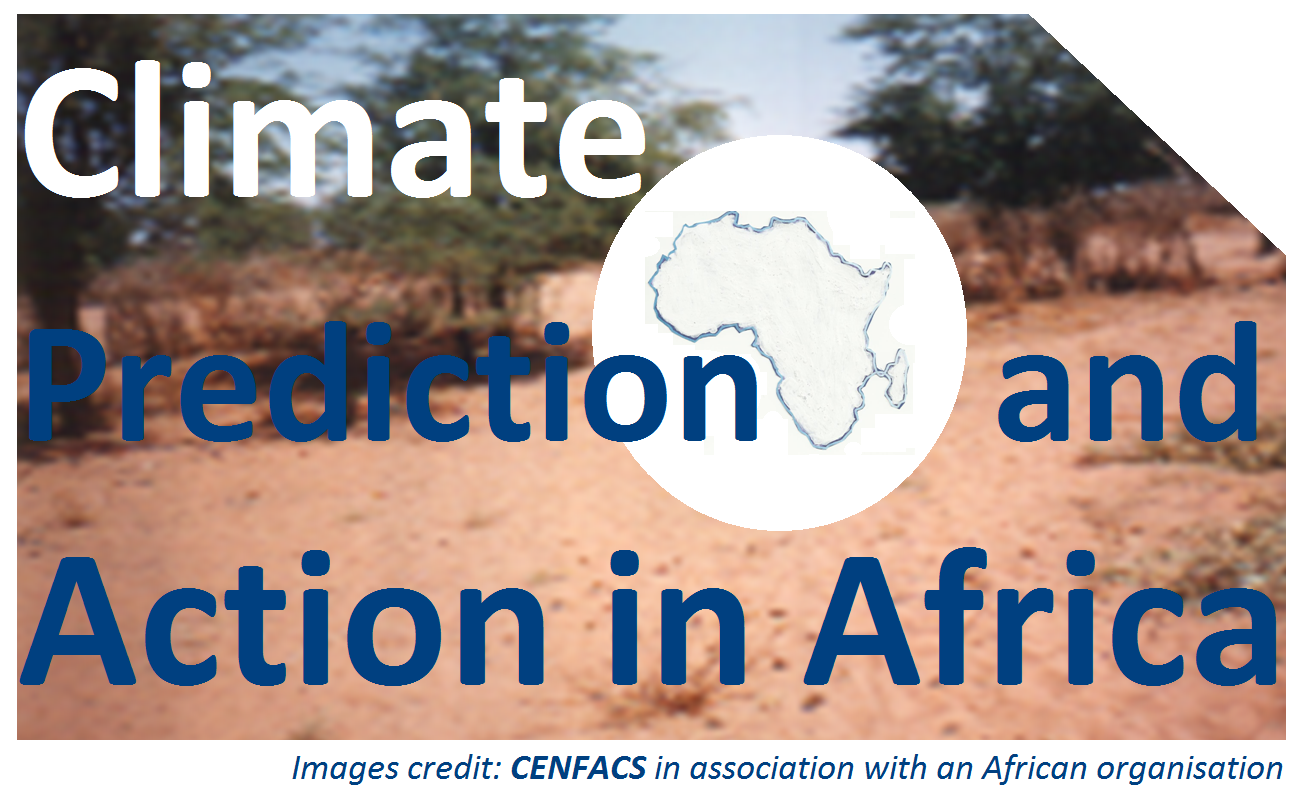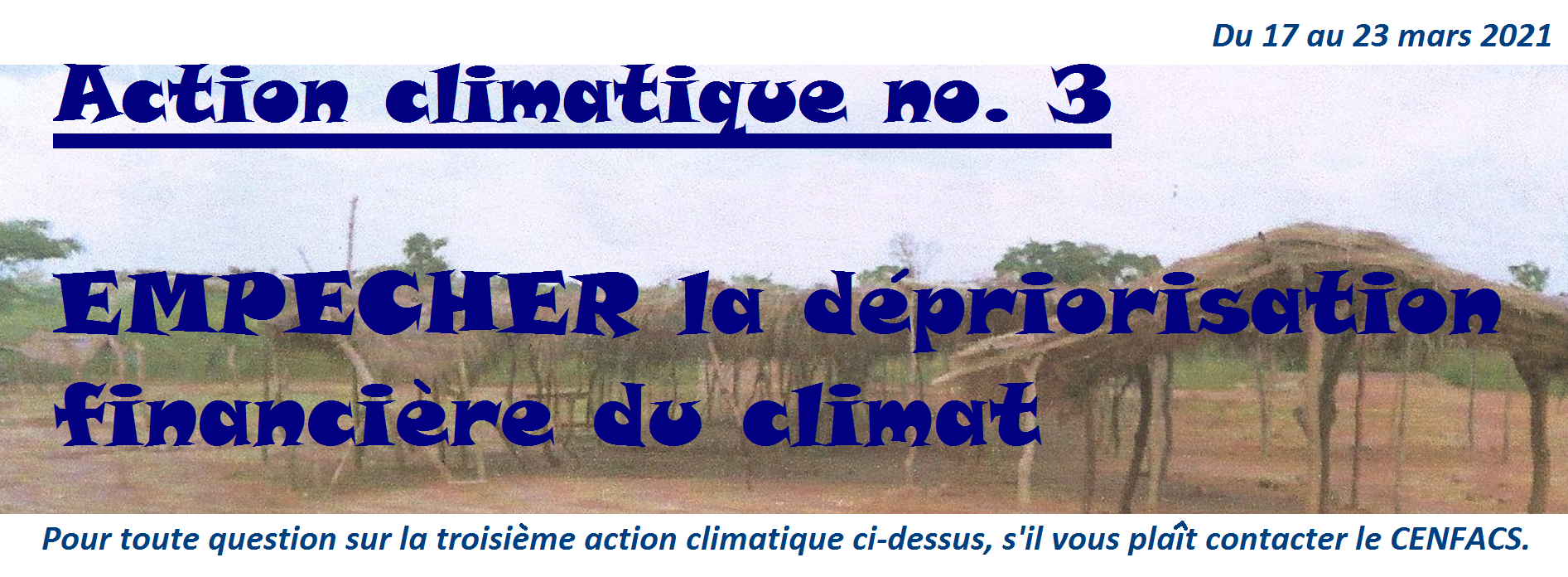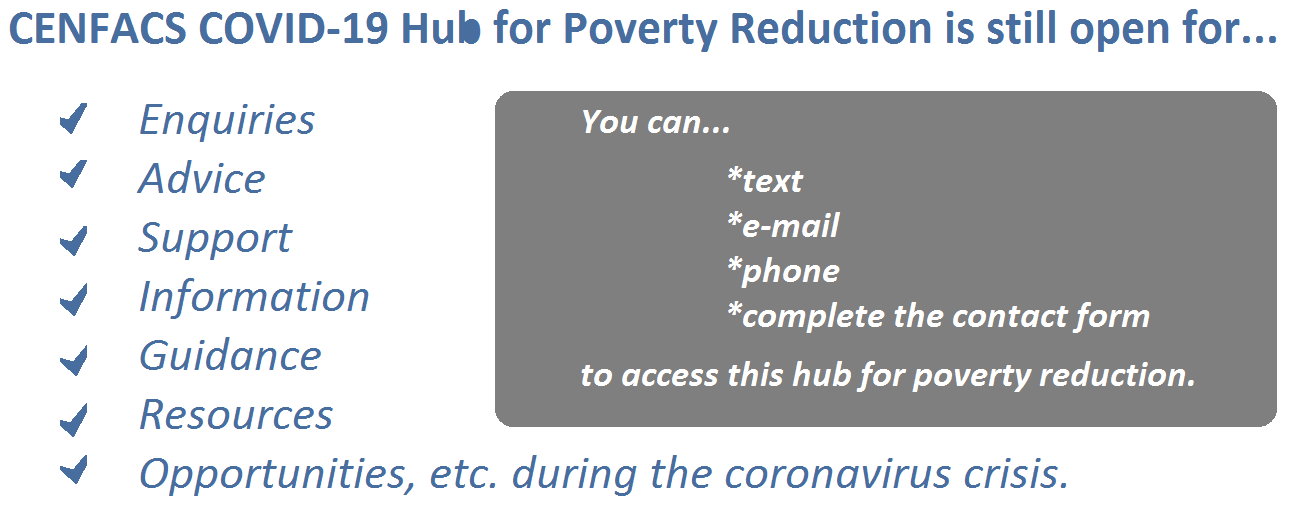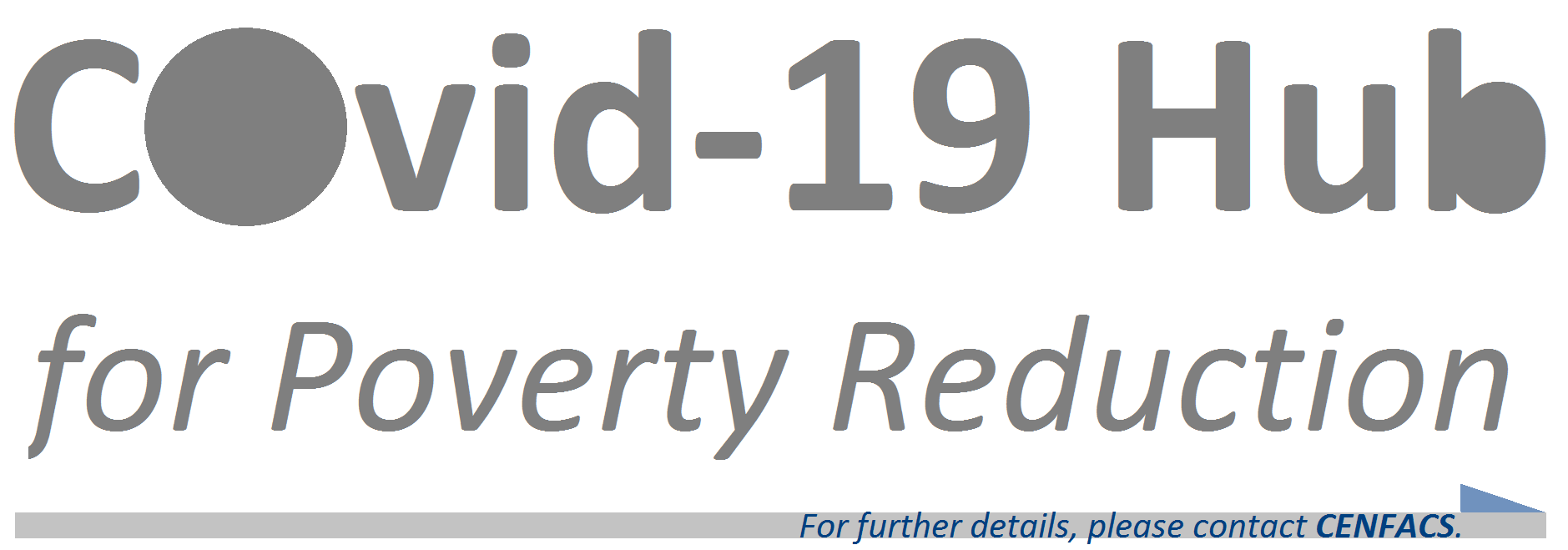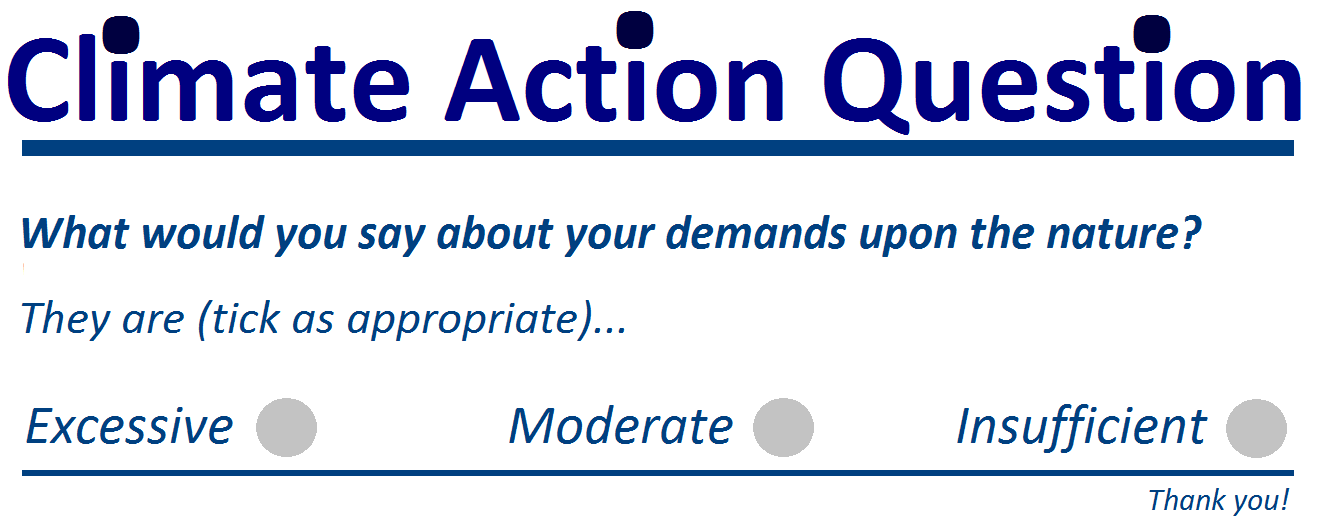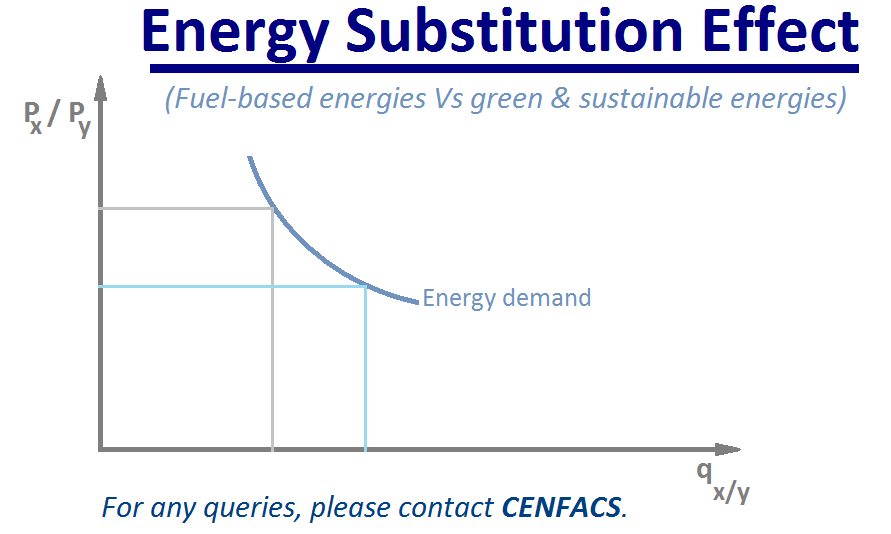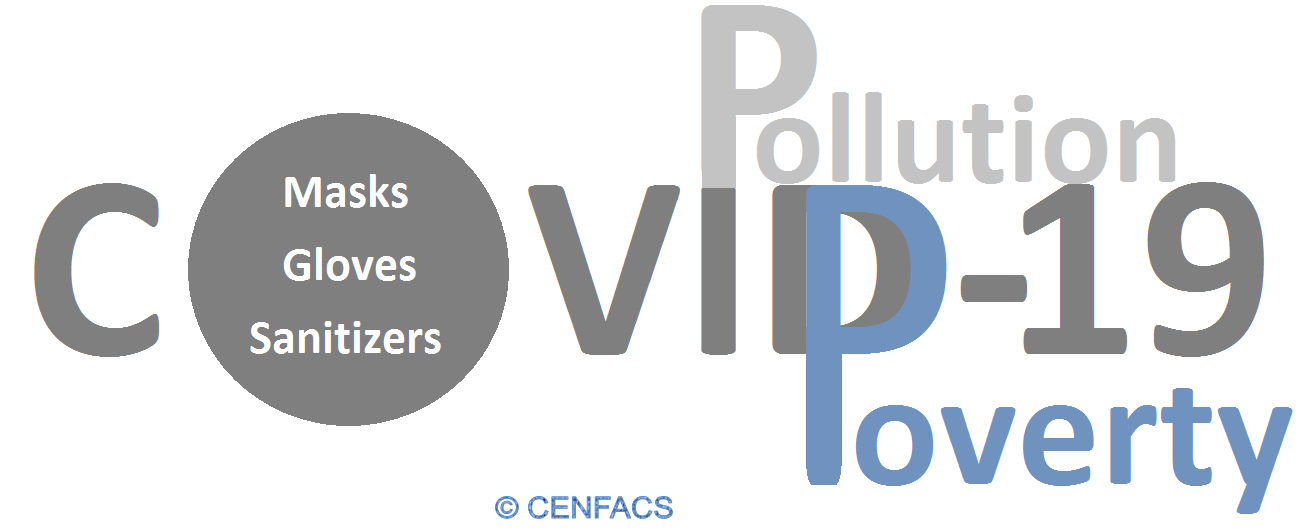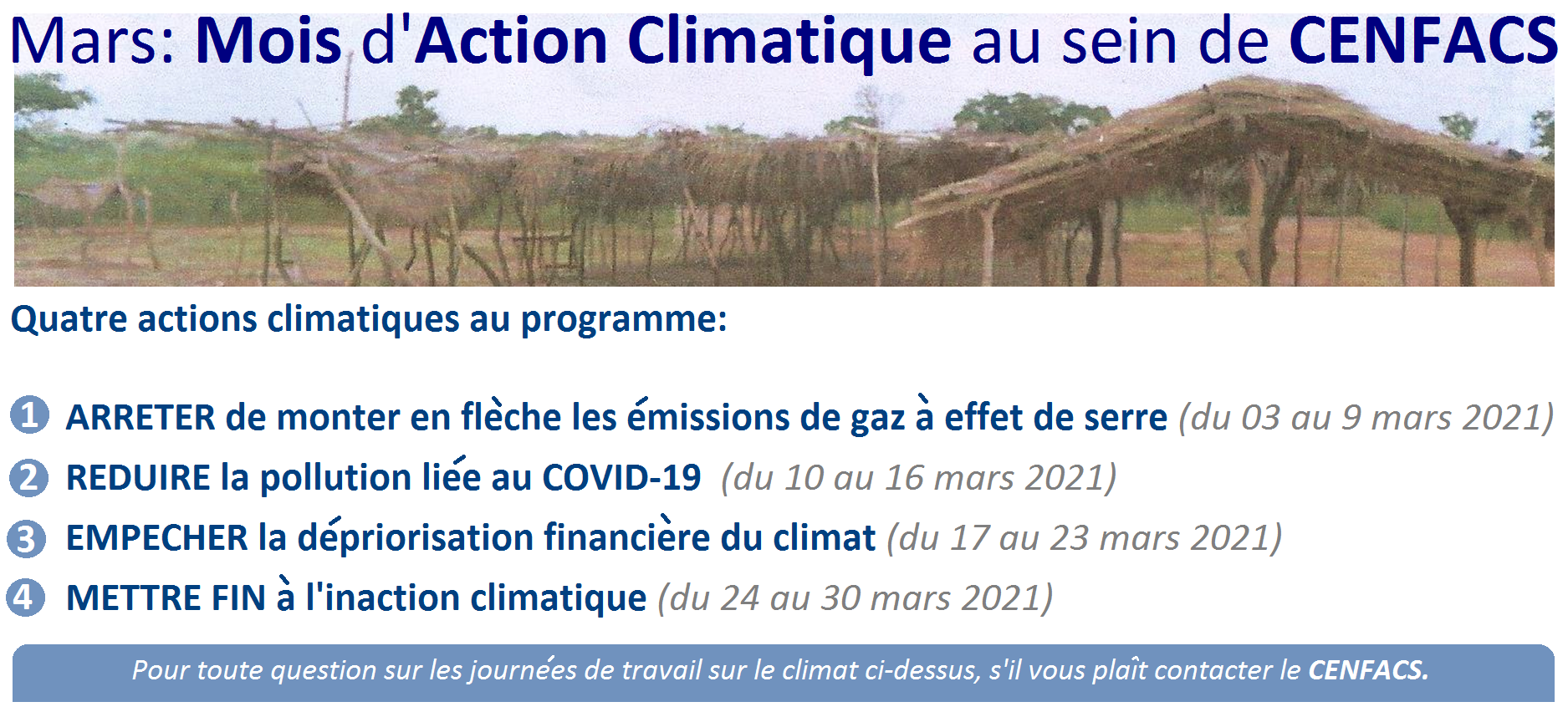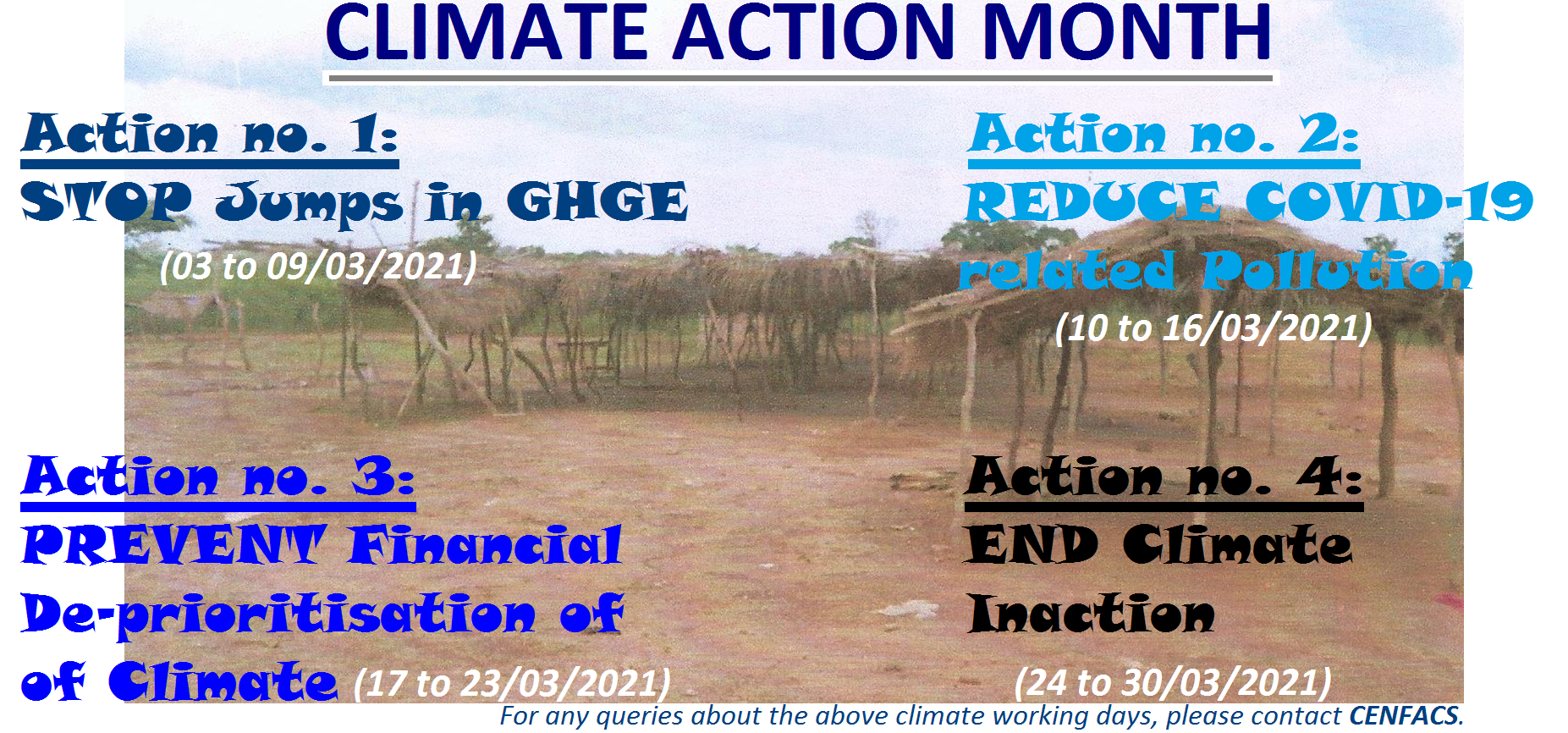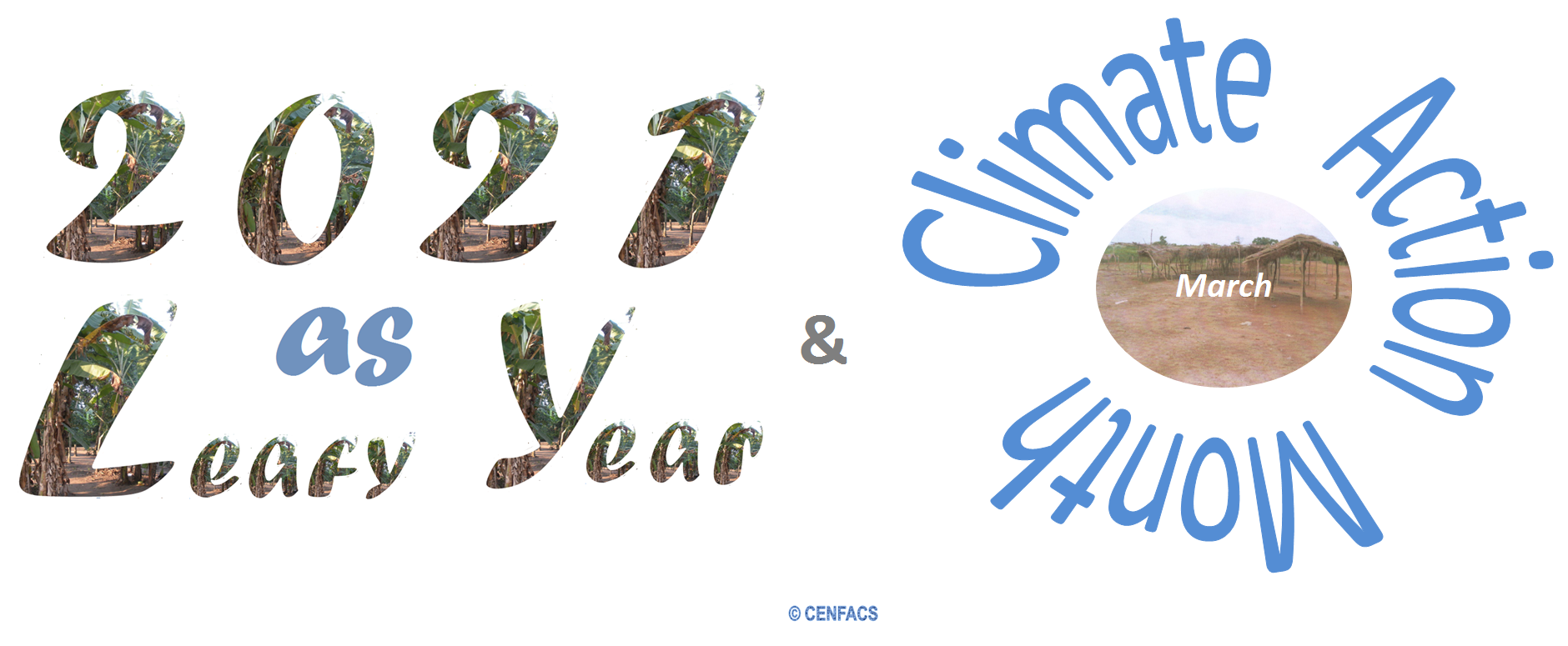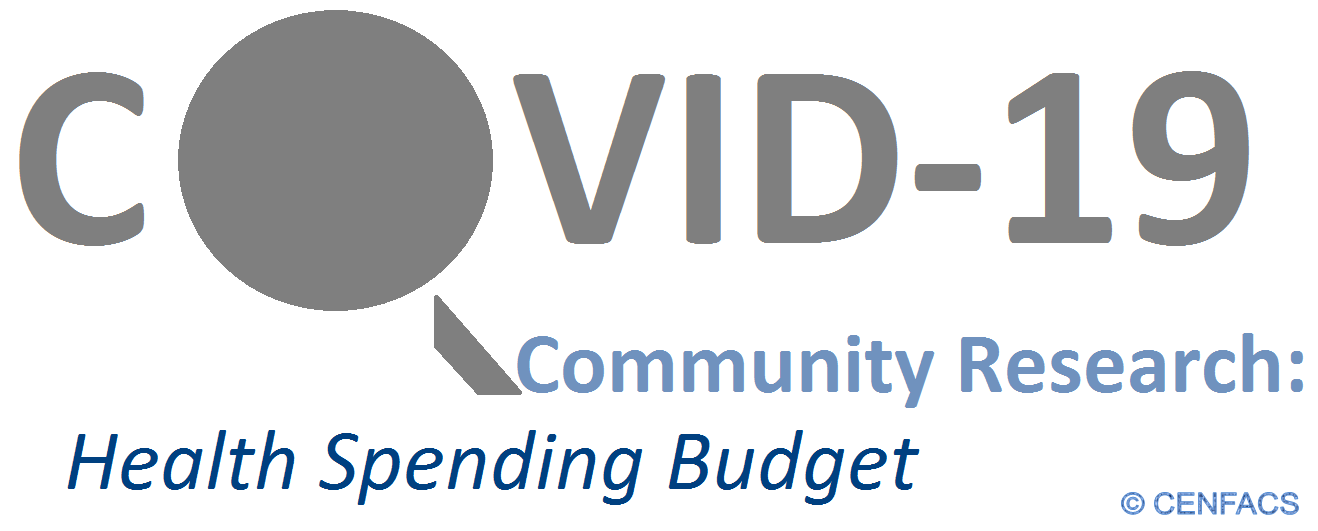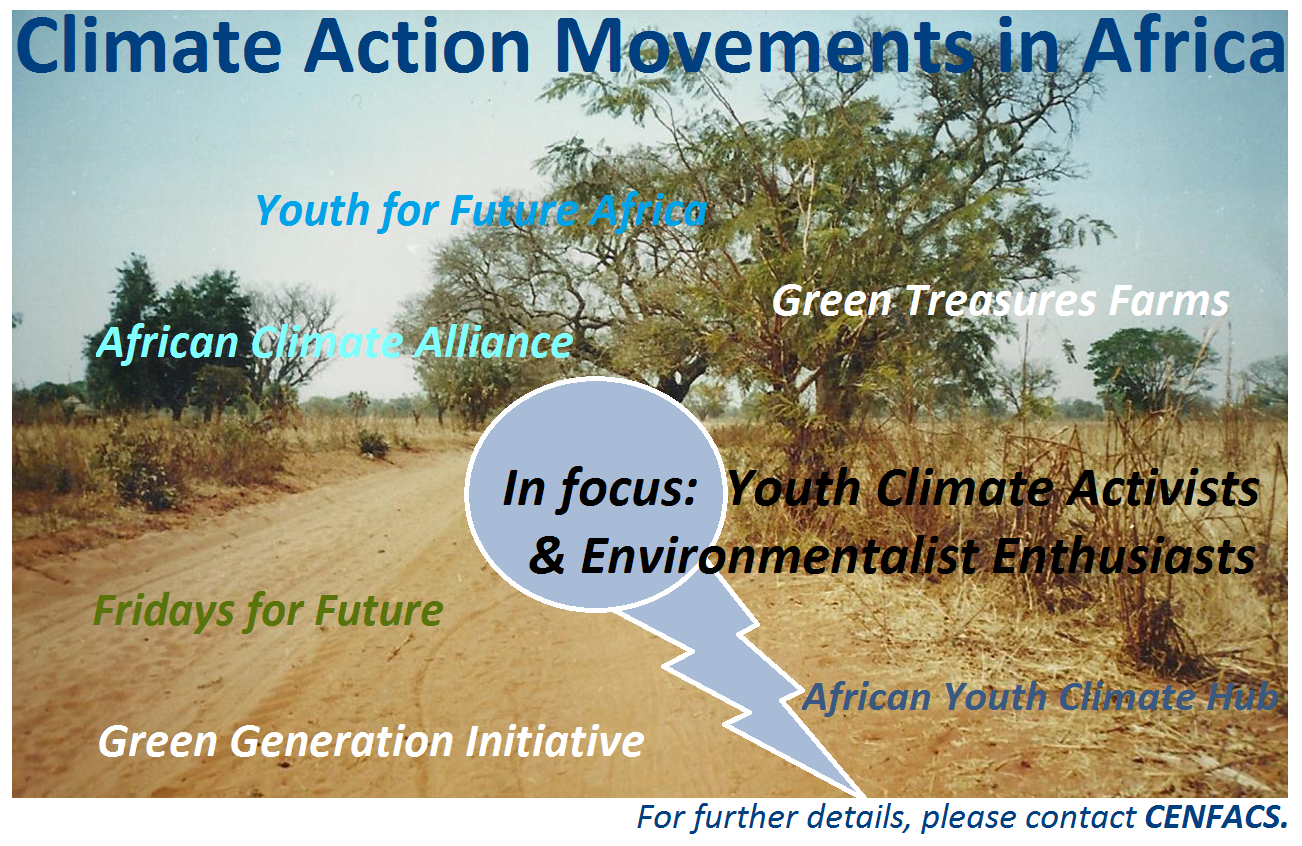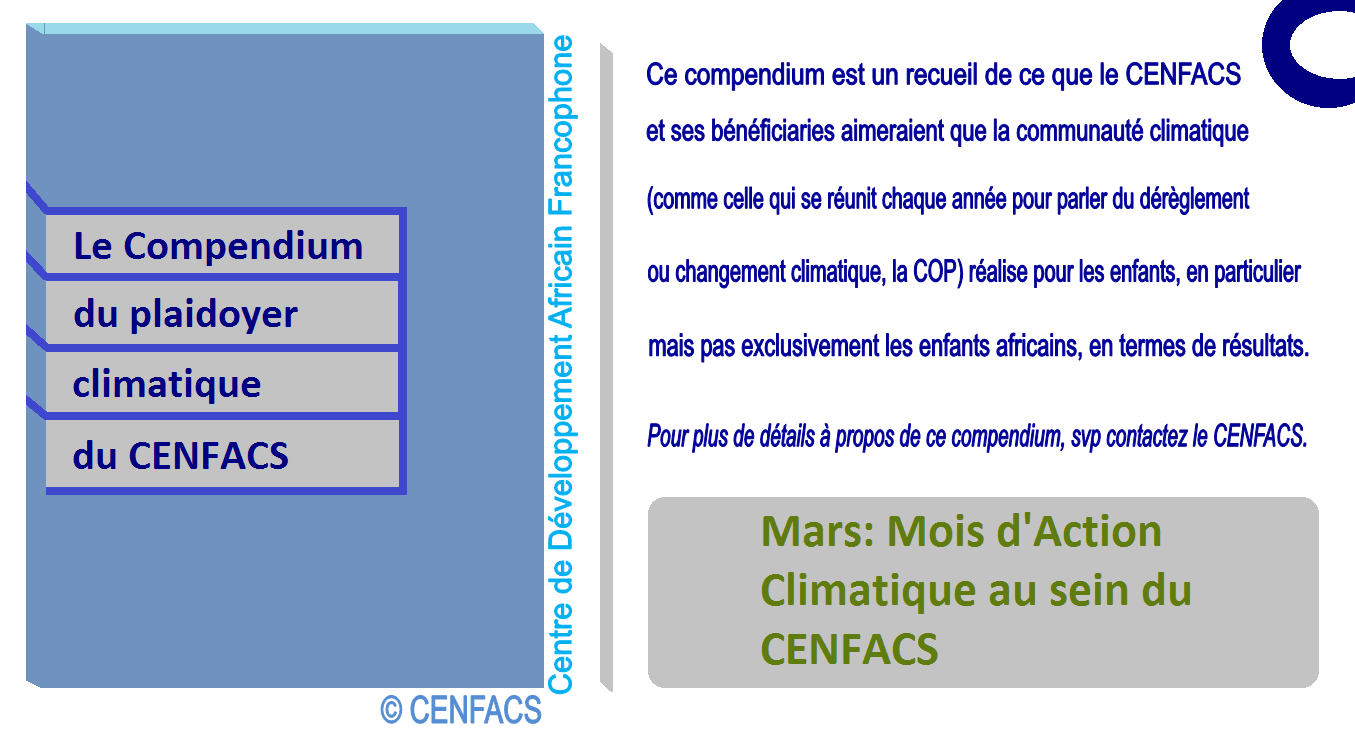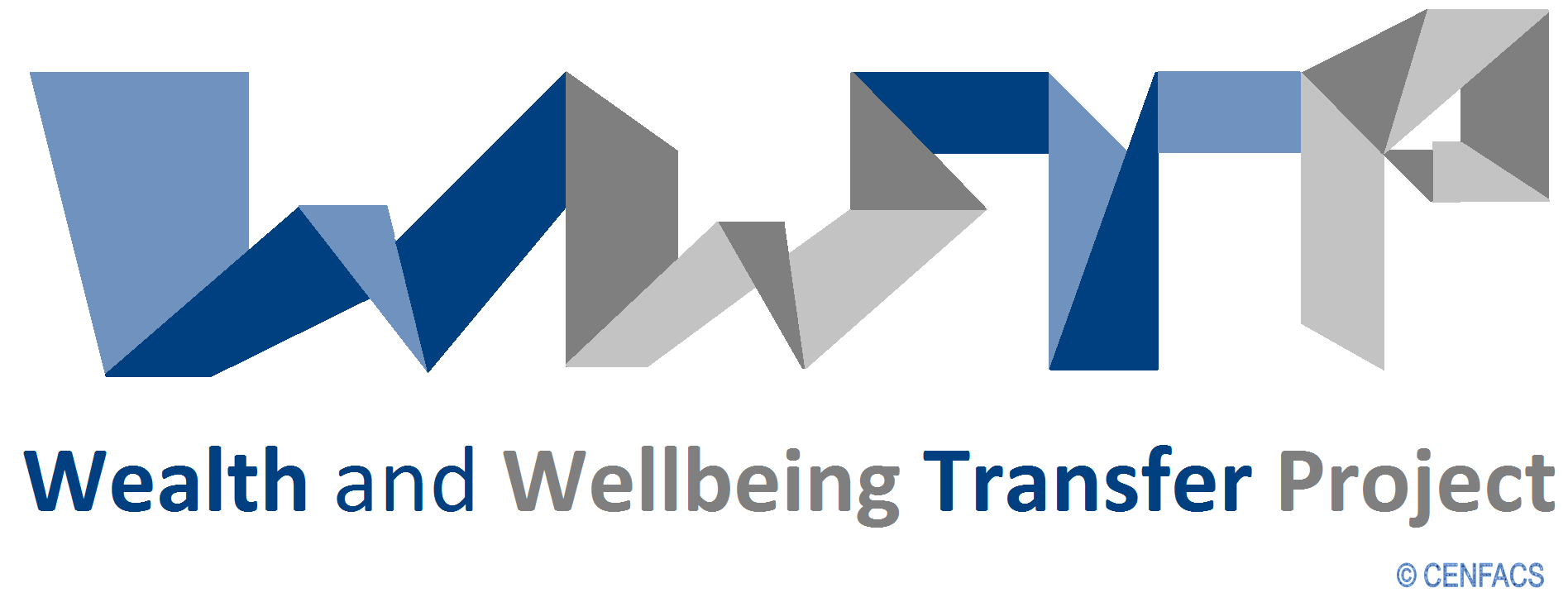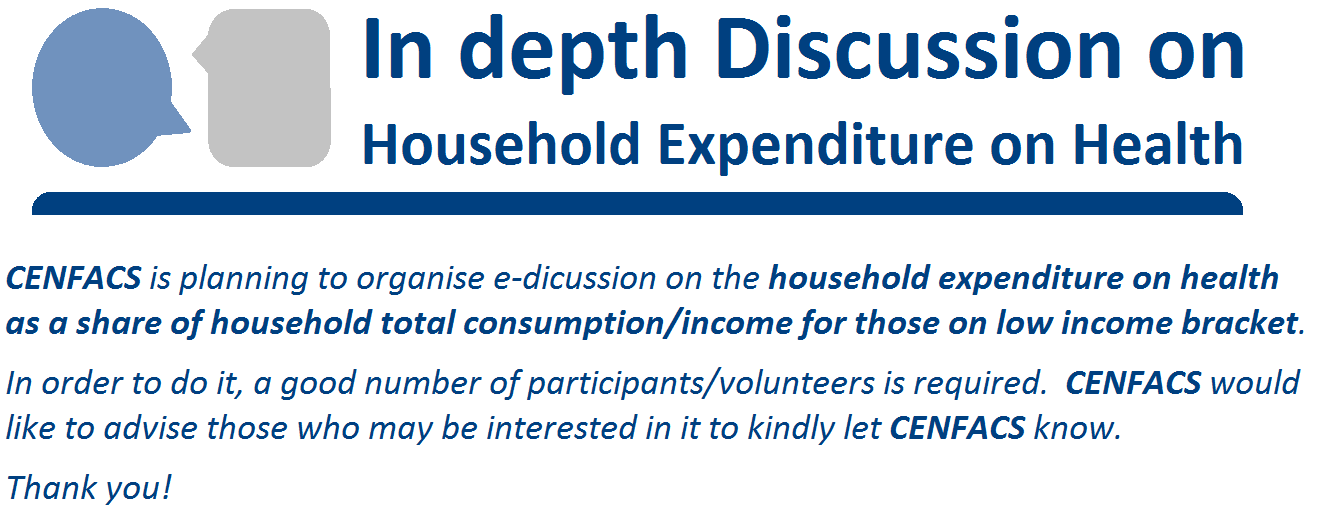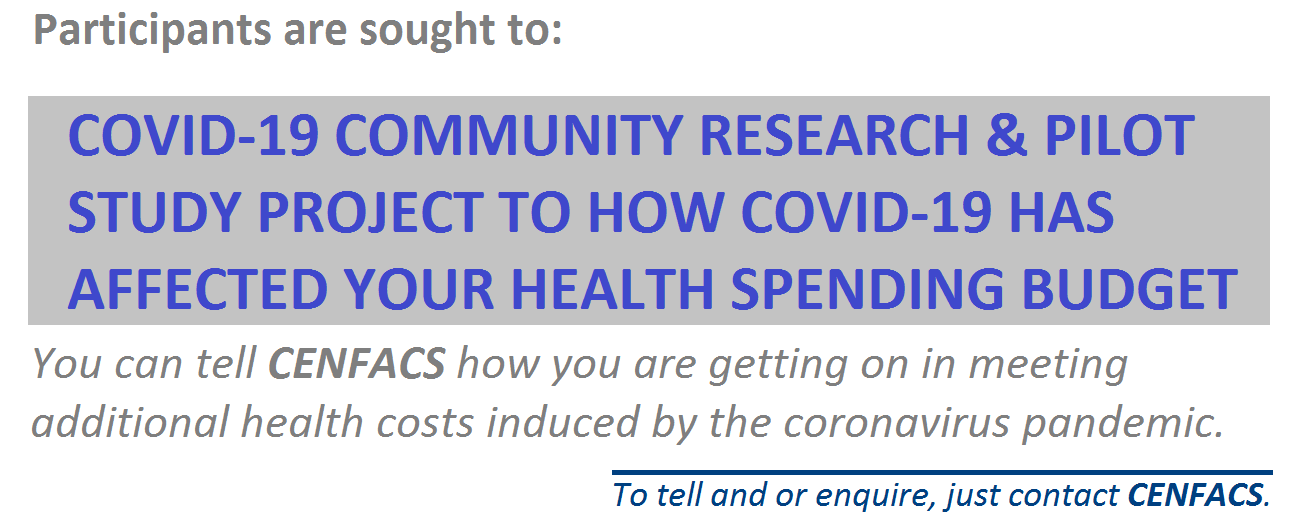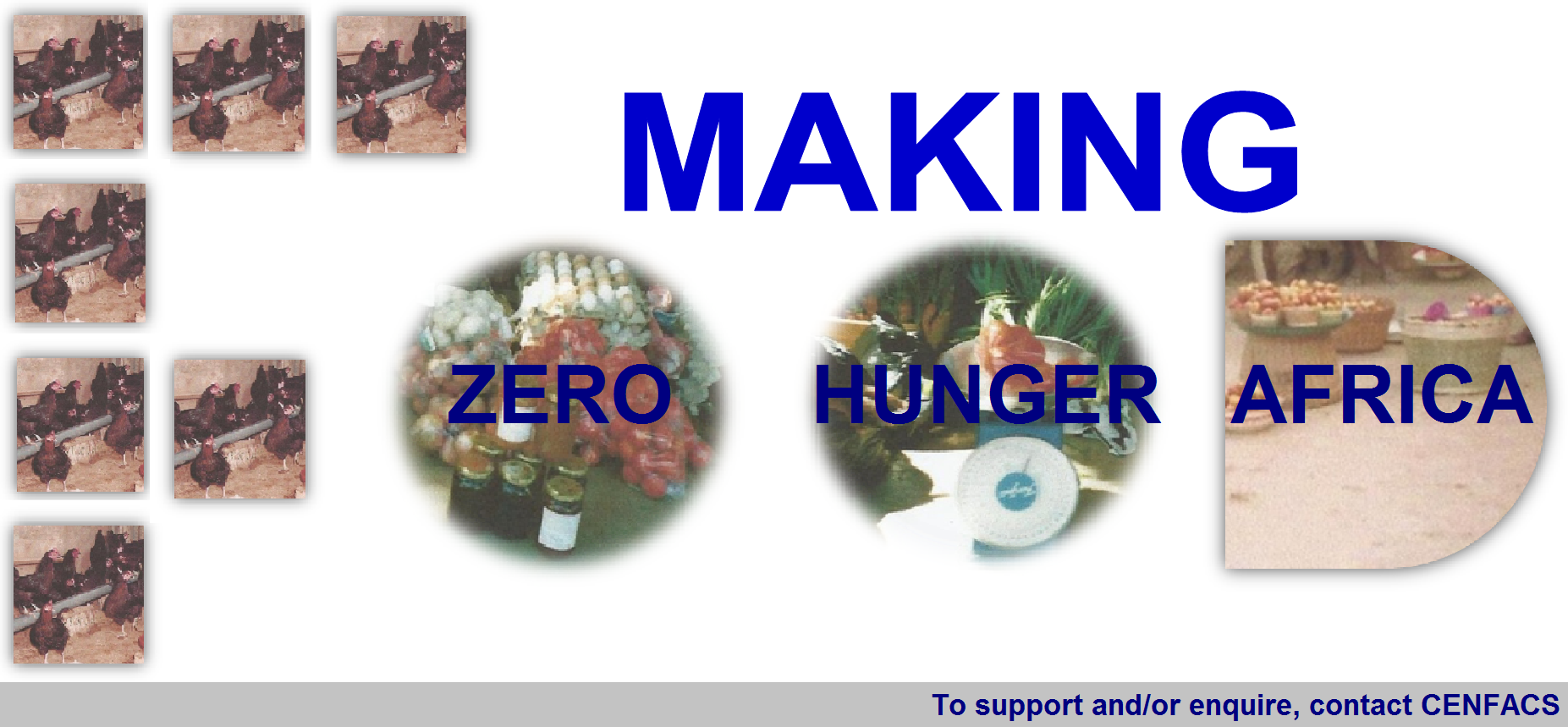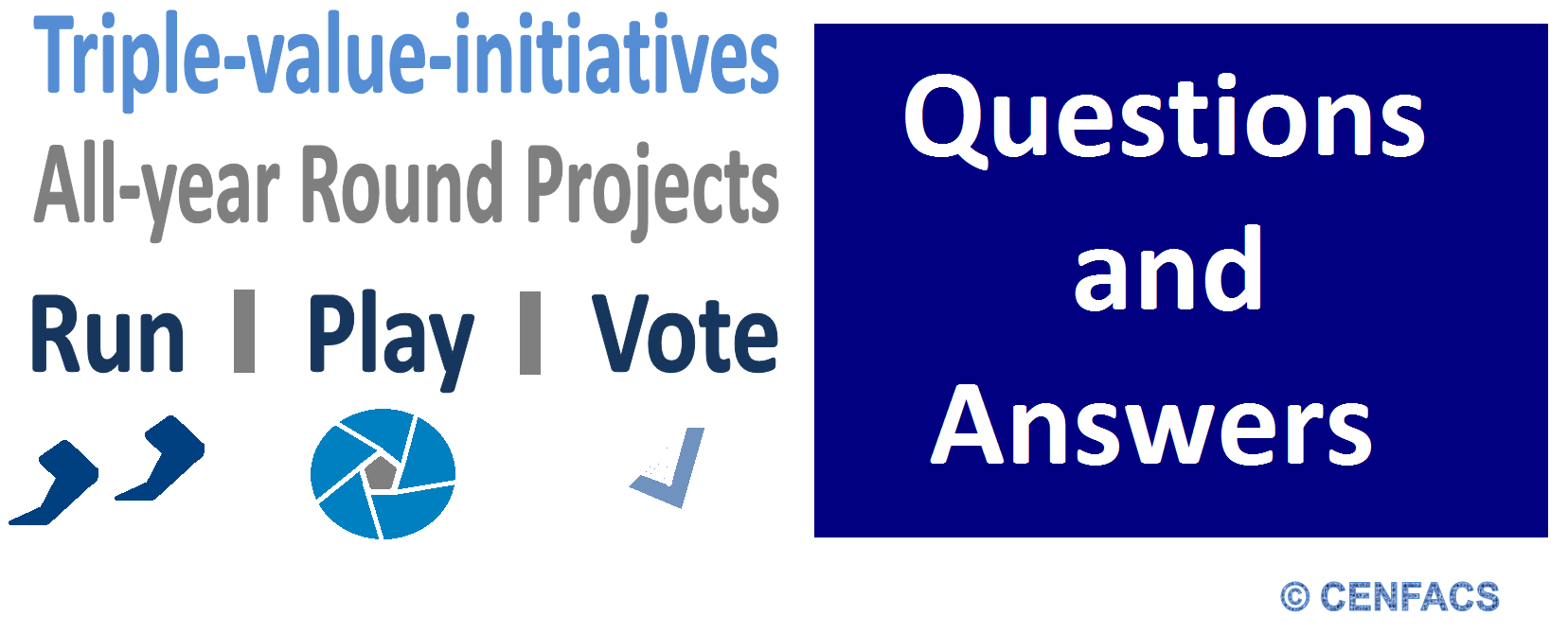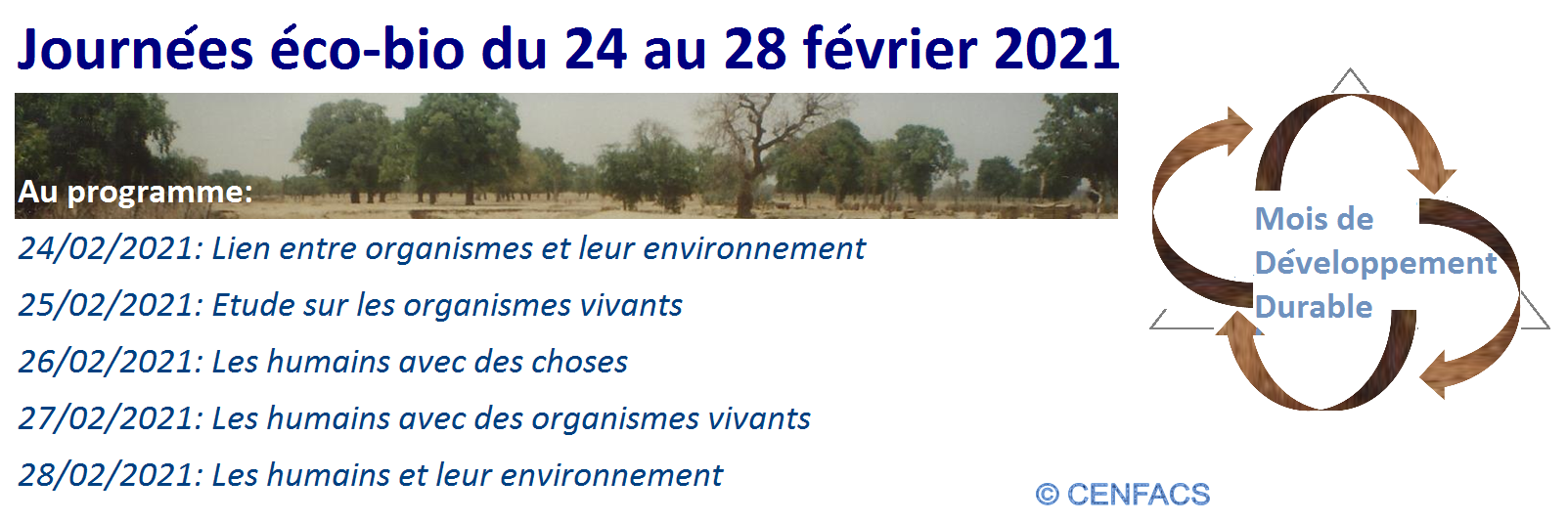Welcome to CENFACS’ Online Diary!
28 April 2021
Post No. 193
The Week’s Contents
• FACS, Issue No. 71, Spring 2021: African Not-for-profit Organisations and the African Continental Free Trade Area
• Protection against Future Shocks and Disasters (Protection Key Notes 4 for Week Beginning Monday 26/04/2021)
• An Update of CENFACS’ Poverty Reduction Tools Box
… And much more!
Key Messages
• FACS, Issue No. 71, Spring 2021: African Not-for-profit Organisations and the African Continental Free Trade Area
How the African not-for-profit organisations can get the best of the game from a free trade area
There are pros and cons about any free trade areas. Without selling the benefits of the African Continental Free Trade Area (ACFTA), the 71st Issue of FACS supports the narrative that it is possible for the African Not-for-profit Organisations (AN4POs) like CENFACS’ Africa-based Sister Organisations to explore market niches and opportunities within the ACFTA so that they can deliver better and more poverty-reduction outcomes beyond their original borders.
For example, the World Bank Group (1) argued in 2020 that
“At the moderate poverty line of PPP (purchasing power parity) US$ 5.5 a day, African Continental Free Trade Area has the potential to lift 67.9 million people, or 3.6 per cent of the continent’s population, out of poverty by 2035” (p. 7)
The above number or percentage is a huge market niche or opportunity for the AN4POs. In this respect, the Issue reinforces the current running argument about reaping off the benefits from the economic space that the ACFTA will provide.
The Issue goes further in advocating that the AN4POs can use the leverage that would be provided by the ACFTA to form and/or develop poverty-reduction alliances or improve their existing links with other organisations of similar aims operating on the African soil in order to better deliver cross-border poverty-reduction outcomes, especially in the post-coronavirus and post-carbon emissions eras.
Furthermore, the Issue explains that the AN4POs can together improve value chains within their own organisations while developing poverty-reduction value chains across Africa. This will help them deliver far-reaching poverty-reducing outcomes or poverty-reduction creating effects to those in need in Africa. It is in this way they can gain in the game of the ACFTA.
Under the Main Development section of this post, we have given Key Summaries making the contents pages of FACS Newsletter, Issue No. 71 of Spring 2021.
• Protection against Future Shocks and Disasters
(Protection Key Notes 4 for Week Beginning Monday 26/04/2021)
Last week, we started this area of protection relating to future shocks and disasters when we presented the 11th Edition of our Reflection Day (held on 27/04/2021) which focussed on the Protection of Women and Children against Future Shocks, Risks and Crises.
We can refer to what we argued about the Reflection Day in order to strengthen protection against future shocks and disasters. We are doing it with in mind the needs of poor people and the CENFACS Community. However, before going any further in this presentation of protection key notes 4, let us try to understand the meanings of shock and disaster.
• • Meanings of future shock and disaster
There are many definitions of future shock and disaster. For the purpose of these notes, we are referencing to the definition of Alvin Toffler (2) who argues that
“Future shock is a certain psychological state of individuals and entire society”
Psychological state of individuals and entire society can be affected by certain events such as food scarcity, climate change, the extinction of fish, infectious disease (like the coronavirus), etc. For example, the impact of COVID-19 ripples across every community including the CENFACS Community.
As to disaster, we are borrowing its definition from the United Nations International Strategy for Disaster Risk Reduction (3); definition which is:
“a serious disruption of the functioning of a community or a society involving widespread human, material, economic or environmental losses and impacts, which exceeds the ability of the affected community or society to cope using its resources” (p. 4)
Disasters can be natural (e.g. wild fires, global drought, etc.), economic (e.g. global economic collapse), health (e.g. the coronavirus pandemic), etc.
These future shocks and disasters can be predicated or unpredictable. Whether or not they can be predicted, one needs to plan protection should they occur.
• • Protection against future shocks and disasters
Self-protection or protecting poor people and communities from the adverse impacts of the eruption of future shocks and disasters means erecting defence against those shocks and disasters that are likely to happen. As part of this protection process, one can use their foresight and work with the potential victims of these shocks and disasters to help them reduce their risks; manage them and adapt to the new normal.
For example, the economist Federico Dominguez (4) in his work argues that the decade 2020-2029 will be the Decade of Turbulence. If this turbulence will happen and will be caused by future shocks and disasters, then protection would be needed for the potential victims of these future shocks and disasters.
The above protection notes are the last for our Protection Month. For those who would like to discuss with us about the Month of Protection and the different notes developed to cover it, they are welcome to contact CENFACS.
• An Update of CENFACS’ Poverty Reduction Tools Box
In the light of the COVID-19 evolution and experience, we have carried out a risk assessment of CENFACS’ Poverty Reduction Tools Box which we created in 2020. As a result of this risk assessment, we have included COVID-19 protection items such as hand sanitising bottles, gloves, face coverings and other personal protection equipment.
These items are related to COVID-19 containment measures. This update is part of the efforts deployed in order to keep the community and general public safe from the coronavirus pandemic.
Likewise, we have aligned the tools that this box contains to greenhouse gas (GHG) emissions reduction goal targets in the process of building forward together greener and cleaner. In doing so, we hope to continue to help reduce poverty with tools that are COVID-19 proof and aligned to GHG emissions reduction goal targets.
In these processes of updating and alignment, we have taken into consideration the current, changing and emerging needs of the community.
For any enquiries about these updates and any of the tools constituent the above mentioned box, please do not hesitate to contact CENFACS.
Extra Messages
• Coming in May 2021: Volunteering Stories of Building Back Better from the COVID-19 Disaster
This year’s All in Development Stories will be about how people and communities are trying or have tried to build back better from the coronavirus disaster and continuing lockdowns. We said better because we want to encourage those who will read All in Development Stories to be positive and optimistic about their future despite the COVID-19 upset.
This year’s stories are those of recovery, rehabilitation and reconstruction from the shock and disaster caused by the coronavirus pandemic and associated lockdowns. They are the tales of physical, social, environmental and economic building back better.
For further details including the agenda for this year’s May Stories, please contact CENFACS.
• Building Forward Better Together Greener and Cleaner with the “Pandemial Generation”
This week, we are also working on our post-coronavirus programme of Building Forward Better Together Greener and Cleaner. We are doing through the African Children’s Climate and Sustainable Development Goals project or Global Goals Generation project, in which we use African children as a sample. Some of these children may become the “Pandemial Generation”. The “Pandemial Generation” or “Pandemials” are defined by the economist Federico Dominguez (op. cit) as
“those young people who are entering the world of work along with the coronavirus crisis”
So, the children generation of the sustainable development goals (that is, children born between 2015 and 2030 during the life time of the United Nations Sustainable Development Goals) could one day become the “Pandemial Generation” because of the long lasting legacies of the coronavirus pandemic. If so, there is need to find ways of working with them so that we can build forward better together greener and cleaner.
Those who may be interested in building forward better together greener and cleaner with the “Pandemials”, they can let CENFACS know.
• Fundraising while Gaming for Poverty Reduction
For those who are playing the CENFACS Poverty Relief League, they can use the opportunity of playing to introduce a giving feature in their game. They can ask those who are involved in the game with them to support good causes in African countries making part of their fixtures and tables. In this way they can help revolutionise the game with a fundraising element while entertaining through the game with or without others.
However, they must remember that the aim of the CENFACS’ League of Poverty Relief is to help African countries reduce poverty by finding out the best performer amongst them in terms of poverty reduction. The aim of this league is not to raise money.
For those who may be having or are experienced some problems in installing a fundraising feature in the game, they can speak to CENFACS.
CENFACS’ League of Poverty Relief is the world’s only league without relegation. Those countries that do not perform well in terms of poverty reduction get help, not a punishment.
To discuss your progress in the game, the fundraising feature in the game or any other issues relating to All Year Round Projects (Triple Value Initiatives), please do not hesitate to contact CENFACS.
Main Development
• FACS, Issue No. 71, Spring 2021: African Not-for-profit Organisations and the African Continental Free Trade Area
How the African not-for-profit organisations can get the best of the game from a free trade area
The contents and key summaries of the 71st Issue of FACS are given below.
• • Contents and Pages
Free trade development and not-for-profit development (Page 2)
Service-creating and –diverting effects for the African not-for-profit organisations (AN4POs) within the ACFTA (Page 3)
ACFTA as a framework of continuance of the AN4POs’ work (Page 4)
Quel est l’espace économique des organisations africaines à but non lucratif dans la zone de libre-échange continentale africaine (ZLECA)? (Page 5)
Les organisations africaines à but non lucratif (OABNL) et la résorption des goulots d’étranglement économique liés à la zone de libre-échange (Page 5)
La ZLECA et la facilitation de la création des chaînes de valeurs de réduction de la pauvreté au sein des OABNL (Page 6)
Les OABNL et les économies d’échelle au sein de la ZLECA (Page 6)
ACFTA as a way of improving financial bargaining power (Page 7)
Outward- and inward-looking poverty reduction policies within ACFTA (Page 7)
Not-for-profit foreign direct investment in the AN4POs in the context of ACFTA (Page 8)
Help to Win Market Niches and Opportunities in the ACFTA (Page 9)
Capacity Development Offer! (Page 9)
Survey about gains and losses for the AN4POs in the ACFTA (Page 9)
Game of the Not-for-profit Developers (Page 10)
• • Key Summaries
Please find below the key summaries of the 71st Issue of FACS from page 2 to page 10.
••• Free trade development and not-for-profit development (Page 2)
Economically speaking, a free trade area would be a sort of economic integration in which free internal trade will be established between country members but each member would be free to levy different external tariffs against non-members. In this kind of trade integration model, the emphasis is on free trade as this is seen as the engine of growth.
However, in places where there is a very high level of poverty like in Africa, this view on economic growth needs to be balanced and to integrate poverty reduction. In those places of high level of poverty, the focus should be on what the free trade can bring to the reduction of poverty, to the quality of life of those who are poor and who make the majority of the free trade area in terms of population.
By looking at things in this way, this raises the debate over the place and role of those organisations that do not have profit as their mission, but can contribute to the development of free trade and of the reduction of poverty at the same time. In other words, the not-for-profit organisations that are specialised in poverty reduction need to have their place and role to play in the achievement of the growth of poverty reduction. It further means that one should look for a pre-distribution of economic growth in terms of economic factors and forces that make it to happen rather than overlooking the redistribution of the fruits of economic growth from a free trade scenario.
The above is our first key summary. For those who would like to further discuss this introductory summary, they are welcome to contact CENFACS.
••• Service-creating and –diverting effects for the African not-for-profit organisations (AN4POs) within the ACFTA (Page 3)
It is hoped that with a fully functioning ACFTA, there would be pan-African service-creating effects for poverty reduction for those AN4POs that would actively engage in poverty reduction work in ACFTA. However, for this to happen, the AN4POs need to have relevant infrastructures, capacities and structures in order to provide poverty-relieving services across the continent or beyond their original borders.
Reciprocally, the potential service beneficiaries in recipient countries need to accept the services to be offered. This is because there could be cultural and ethnic barriers or clashes to non-national service providers.
Furthermore, there could be diversion or redirection of humanitarian relief aid provided by non-members of the ACFTA.
There could be more to argue in terms of service creation and diversion for AN4POs within the ACFTA. For those who have any issues that they want to raise in relation to these effects, they can contact CENFACS.
••• ACFTA as a framework of continuance of the AN4POs’ work (Page 4)
ACFTA can be a model for the continuation of the poverty reduction work that the AN4POs are already doing. This continuation can happen if the mechanism and mechanics of ACFTA provide an enabling environment for the not-for-profit development; not only for those trading goods and services for profit. This is because history shows that there are places in the world with a high return on investment but with a very high level of poverty as well.
Profit making does not always lead to the reduction of poverty. Poverty reduction is not always a direct consequence of profit-making activities. Likewise, poverty reduction does not happen by chance. For poverty reduction to happen, the value of poverty reduction has be embodied or integrated in the processes of production, consumption, distribution and exchange of goods and services, as well as in human relations.
That is why those organisations (like the AN4POs) that seriously take poverty reduction as their core mission are well placed in working on poverty reduction in the game of trade or economic integration. They have to be given the right space and means to expand the benefits of what they are already doing at local and national levels (of poverty reduction) across the continental free trade area.
For any queries about the kind of place that the AN4POs need to be given in the ACFTA, please do not hesitate to contact CENFACS.
••• Quel est l’espace économique des organisations africaines à but non lucratif dans la zone de libre-échange continentale africaine (ZLECA)? (Page 5)
Quand on parle de la zone de libre-échange, on s’adresse souvent à des organisations important et exportant des marchandises et services pour réaliser le bénéfice ou le profit. L’espace économique est surtout réservé à ce genre d’activités, d’entreprises ou organisations.
Et pourtant, faire du profit n’est pas toujours synonyme de réaliser le bien-être ou la qualité de vies des populations locales, surtout de celles qui vivent dans la pauvreté ou la précarité.
L’espace économique est aussi pour des organisations à but non lucratif qui prennent la réalisation des objectifs de réduction de la pauvreté comme une mission principale de leurs activités.
C’est en intégrant et en donnant une part non négligeable à ce genre d’activités dans l’ensemble commercial continental africain que l’on peut espérer gagner le combat contre la pauvreté en Afrique. C’est-à-dire qu’on jugulera l’épineux problème de pauvreté et de précarité en Afrique quand on donnera à ces organisations à but non lucratif la place qu’elles méritent ou une part égale par rapport aux autres au sein de la zone de libre-échange continentale africaine.
Pour ceux ou celles de vous qui veulent en savoir plus sur ce sujet, s’il vous plaît n’hésitez de contacter le CENFACS.
••• Les organisations africaines à but non lucratif (OABNL) et la résorption des goulots d’étranglement économique liés à la zone de libre-échange (Page 5)
La zone de libre-échange continentale africaine peut subir des goulots d’étranglement liés à des facteurs ci-après: l’offre de proximité, des coûts de transport, des marchés imparfaits et exigus, des écarts technologiques, etc.
En faisant que les OABNL soient une partie intégrante du jeu de l’intégration commerciale continentale, elles peuvent épauler les organisations à but lucratif dans leurs tentatives de résorption de ces maux économiques. Car, les OABNL ont des atouts exceptionnles tels que leur imprégnation dans la vie locale avec des projets locaux.
En gros, les OABNL peuvent être un atout majeur pour les autres organisations commerciales oeuvrant dans la zone en les aidant dans leur tentative de règler ces goulots d’étranglement.
••• La ZLECA et la facilitation de la création des chaînes de valeurs de réduction de la pauvreté au sein des OABNL (Page 6)
Commençons d’abord par définir ce que l’on entend par une chaîne de valeur. Pour le faire, nous allons utiliser la définition de M. Porter (4). Selon lui, l’entreprise est
“un enchaînement d’activités qui permettent de transformer des achats (auprès de fournisseurs de matières premières, biens …) en ventes”.
En partant de cette définition, on peut dire que la chaîne de valeur (c’est-à-dire toutes les étapes dans la conception, la fabrication et la distribution d’un produit) peut jouer un rôle pour la réduction de la pauvreté.
Les OABNL peuvent établir des chaînes de valeurs leur permettant de réduire la pauvreté. De même, elles peuvent utiliser l’espace de la ZLECA pour en faire advantage. En d’autres mots, elles peuvent localiser les sources de différenciation de leurs organisations et identifier là où la valeur de réduction de la pauvreté peut se créer. Ce qui peut leur donner un avantage compétitif en matière de réduction de la pauvreté.
Ces chaînes offrent aux OABNL la possibilité de s’insérer dans l’économie de la ZLECA et de développer des structures leur permettant de réduire la surdépendance aux organisations multinationales à but non lucratif. Elles peuvent par ailleurs améliorer leurs capacités de négociation et corriger l’asymétrie de pouvoir et de relations avec ces organisations multinationales.
Pour plus de détails à propos de ce qui précède, s’il vous plaît contactez le CENFACS.
••• Les OABNL et les économies d’échelle au sein de la ZLECA (Page 6)
La ZLECA peut offrir aux organisations y oeuvrant ou participant des possibilités de réaliser des économies d’echelle. Est-ce que cela va de soi avec les OABNL?
C’est possible pour des OABNL participant dans la ZLECA de réaliser des économies d’échelle qui leur permettront en retour de créer des échelles de réduction de la pauvreté. Elles peuvent réduire leurs coûts unitaires ou moyens de production et distribution de services de réduction de la pauvreté pendant que la dimension de leurs opérations augemente dans la ZLECA. Evidemment, cela dépendra du secteur et de location des OABNL.
Il peut donc y avoir à terme des effets de l’ouverture commerciale sur la dynamique de la croissance de réduction de la pauvreté pour des organisations participantes à la ZLECA.
Pour ceux ou celles qui veulent débattre avec nous cette question sur les économies d’échelle des OABNL, elles peuvent contacter le CENFACS.
••• ACFTA a way of improving financial bargaining power (Page 7)
The AN4POs can use the leverage provided by the free trade area in order to improve their financial negotiation power in international funding market; just as they can tap into any new funding schemes or programmes that could be available for the not-for-profit sector or actors at the level of the ACFTA.
For example, there are funding programmes that are more appealing to organisations working across many borders and delivering services to users in various countries than those working in a single country.
The AN4POs can explore new and emerging funding opportunities that are or will be available within the ACFTA; just as they can bid in the international capital market to secure funds for poverty reduction in the ACFTA. They can as well form a coalition within the ACFTA to appeal for funding to tackle various problems that Africa is facing, such as the elimination of tropical diseases, access to COVID-19 vaccines for the poorest people, etc.
Briefly, there are ways of increasing and improving the financial bargaining power and position of the AN4POs within the framework of ACFTA.
••• Outward- and inward-looking poverty reduction policies within ACFTA (Page 7)
The AN4POs can work in order to increase the rate of self-reliance between them while promoting indigenous and local technologies and innovative ways to reduce poverty. They can assess the potential resources and opportunities given by the ACFTA and see how they can increase their level of self-reliance. Where they fall short, they can evaluate by how much inward-looking services can fill the gap.
They should carry out a prudent and intelligent mix of inward- and outward-looking policies in order to continue their journey of poverty reduction and sustainable development. This requires pragmatism. They should not expect the ACFTA to provide all the answers to the problem.
In short, it is possible to get the best of ACFTA by conducting a clever mix of both outward- and inward-looking poverty reduction policies.
••• Not-for-profit foreign direct investment in the AN4POs in the context of ACFTA (Page 8)
The AN4POs can work to attract part of incoming foreign direct investment (FDI) that the ACFTA may benefit as a result of continental free trade area. This part of FDI could be the one coming from overseas development organisations or non-trading arms of some multinational corporations.
For example, at the moment there are binding contracts or legislation in some places that force foreign multinational corporations to invest in local poverty reduction projects, green projects, programmes for much-needed support to marginalised communities, climate resilience and health initiatives, projects to reduce plastic pollution and waste, etc.
The AN4POs can get involved in those types of projects or programmes in the context of the ACFTA. The principles of a free trade area can give them impetus to be more ambitious and grab the markets where legislation is permitted within the ACFTA.
It may be too early to think of this kind of market opportunities. However, as the ACFTA develops, this sort of opportunities could become clearer and wider.
••• Help to Win Market Niches and Opportunities in the ACFTA (Page 9)
Does any African organisation is interested in training, seminars, webinars, online discussions, forums and conferences, etc. in order to access the opportunities of the ACFTA?
••• Capacity Development Offer! (Page 9)
Does your organisation have the necessary and required capacity to provide cross-border services in the context of ACFTA?
If not, CENFACS can work with your organisation to find the right capacity to build and/or develop to enter and / or sustain in the economic space provided by the ACFTA.
Need capacity development; please do not hesitate to contact CENFACS.
••• Survey about gains and losses for the AN4POs in the ACFTA (Page 9)
There are advantages and disadvantages deriving from the ACFTA for the AN4POs. Further to these advantages and disadvantages, CENFACS is carrying a survey to evaluate the gains and losses for the AN4POs. As a part of this survey, we have developed a questionnaire to help you give your views. One of the questions in this questionnaire is:
Do you think that the ACFTA will benefit the not-for-profit development in Africa?
••• Game of the Not-for-profit Developers (Page 10)
The Game of the Not-for-profit Developers (or the Game of the African Not-for-profit Organisations in the African Continental Free Trade Area) is an investigative project that aims to help African Not-for-profit Organisations to get the best of the African Continental Free Trade Area so that they can expand their outcomes in terms of poverty reduction, and in doing so help lift more people out of poverty in Africa or in this area.
The project, which is not a sum of recreational activities, is a model of decision-making process that analyses the threats and risks deriving from the trading space provided by the ACFTA while identifying the opportunities that can be reaped off from the same space.
The investigative project takes into account the local needs as well as the conflicting interests of the other game players and their choices.
For details including full project proposals and budget for the Game of the Not-for-profit Developers, please contact CENFACS.
The full copy of the 71st Issue of FACS is available on request.
For any queries and comments about this Issue, please do not hesitate to contact CENFACS.
_________
References
(1) World Bank Group (2020), The African Continental Free Trade Area: Economic and Distributional Effects, World Bank Publications, Washington, D. C.
(2) Alvin Toffler (1970), Future Shock, Pandom House
(3) United Nations International Strategy for Disaster Risk Reduction (2009), United Nations International Strategy for Disaster Reduction, UNISDR Terminology on Disaster Risk Reduction
(4) Federico Dominguez (2021), La Rebelión de los Pandemials, Editores Argentinos
_________
Help CENFACS keep the Poverty Relief work going this year.
We do our work on a very small budget and on a voluntary basis. Making a donation will show us you value our work and support CENFACS’ work, which is currently offered as a free service.
One could consider a recurring donation to CENFACS in the future.
Donate to support CENFACS!
FOR ONLY £1, YOU CAN SUPPORT CENFACS AND CENFACS’ PROJECTS, JUST GO TO http://cenfacs.org.uk/supporting-us/
Thank you for visiting CENFACS website and reading this post.
Thank you as well to those who made or make comments about our weekly posts.
We look forward to receiving your regular visits and continuing support throughout 2021 and beyond.
With many thanks.
